Visualization of Urban Mobility Data from Intelligent Transportation Systems
Abstract
1. Introduction
1.1. Motivation
1.2. Contributions
1.3. Outline
2. Literature Review
- Which phenomena related to transportation have been analyzed using visualizations and which types of data have been exploited?
- How traditional techniques have been used, and which novel techniques have been proposed?
- Urban traffic flows and monitoring;
- People dynamics in urban environments;
- Road traffic incidents;
- Air pollution.
2.1. Urban Traffic Flows and Monitoring
2.2. People Dynamics in Urban Environments
2.3. Road Traffic Incidents
2.4. Air Pollution
2.5. Travel Behavior on Public Transportation Systems
2.6. Level of Service on Public Transportation Systems
2.7. Trip Patterns
2.8. Other Topics
3. Conclusions
Funding
Acknowledgments
Conflicts of Interest
Abbreviations
| AFC | Automatic Fare Counting |
| ANPR | Automatic Number-plate Recognition |
| APC | Automatic Passenger Counting |
| AVL | Automatic Vehicle Location |
| CoAXs | Collaborative Accessibility-Based Stakeholder Engagement for Public Transportation Planning |
| D2ITS | Data-Driven Intelligent Transportation System |
| GIS | Geographic Information System |
| GPS | Global Positioning System |
| GTFS | General Transit Feed Specification |
| ICT | Information and Communication Technology |
| ITS | Intelligent Transportation Systems |
| PTS | Public Transportation System |
| VDGIS | Very Dynamic Geographic Information Systems |
References
- Serrano, W. Digital Systems in Smart City and Infrastructure: Digital as a Service. Smart Cities 2018, 1, 134. [Google Scholar] [CrossRef]
- United Nations. World Urbanization Prospects: The 2014 Revision; United Nations: New York, NY, USA, 2014. [Google Scholar] [CrossRef]
- Chen, W.; Guo, F.; Wang, F.Y. A Survey of Traffic Data Visualization. IEEE Trans. Intell. Transp. Syst. 2015, 16, 2970–2984. [Google Scholar] [CrossRef]
- Batty, M. Editorial: Big Data, Cities and Herodotus. Built Environ. 2016, 42, 317–320. [Google Scholar] [CrossRef]
- Andrisano, O.; Bartolini, I.; Bellavista, P.; Boeri, A.; Bononi, L.; Borghetti, A.; Brath, A.; Corazza, G.E.; Corradi, A.; de Miranda, S.; et al. The Need of Multidisciplinary Approaches and Engineering Tools for the Development and Implementation of the Smart City Paradigm. Proc. IEEE 2018, 106, 738–760. [Google Scholar] [CrossRef]
- Gharaibeh, A.; Salahuddin, M.A.; Hussini, S.J.; Khreishah, A.; Khalil, I.; Guizani, M.; Al-Fuqaha, A. Smart Cities: A Survey on Data Management, Security, and Enabling Technologies. IEEE Commun. Surv. Tutor. 2017, 19, 2456–2501. [Google Scholar] [CrossRef]
- Andrienko, G.; Andrienko, N.; Chen, W.; Maciejewski, R.; Zhao, Y. Visual Analytics of Mobility and Transportation: State of the Art and Further Research Directions. IEEE Trans. Intell. Transp. Syst. 2017, 18, 2232–2249. [Google Scholar] [CrossRef]
- Claramunt, C.; Jiang, B.; Bargiela, A. A new framework for the integration, analysis and visualisation of urban traffic data within geographic information systems. Transp. Res. Part C Emerg. Technol. 2000, 8, 167–184. [Google Scholar] [CrossRef]
- D3.js - Data-Driven Documents. Available online: https://d3js.org/ (accessed on 15 January 2019).
- Processing.org. Available online: https://processing.org/ (accessed on 15 January 2019).
- Agryzkov, T.; Oliver, J.L.; Tortosa, L.; Vicent, J.F. A Model to Visualize Information in a Complex Streets’ Network. In Distributed Computing and Artificial Intelligence; Omatu, S., Neves, J., Rodriguez, J.M.C., Paz Santana, J.F., Gonzalez, S.R., Eds.; Springer: Cham, Switzerland, 2013; pp. 129–136. [Google Scholar]
- Agryzkov, T.; Oliver, J.L.; Tortosa, L.; Vicent, J.F. Different Types of Graphs to Model a City. Comput. Methods Exp. Meas. XVIII 2017, 118, 71–81. [Google Scholar] [CrossRef]
- Zhang, J.; Wang, F.Y.; Wang, K.; Lin, W.H.; Xu, X.; Chen, C. Data-Driven Intelligent Transportation Systems: A Survey. IEEE Trans. Intell. Transp. Syst. 2011, 12, 1624–1639. [Google Scholar] [CrossRef]
- Chen, S.; Yuan, X.; Wang, Z.; Guo, C.; Liang, J.; Wang, Z.; Zhang, X.L.; Zhang, J. Interactive Visual Discovering of Movement Patterns from Sparsely Sampled Geo-tagged Social Media Data. IEEE Trans. Vis. Comput. Graph. 2016, 22, 270–279. [Google Scholar] [CrossRef]
- Andrienko, G.; Andrienko, N.; Bak, P.; Keim, D.; Wrobel, S. Visual Analytics Focusing on Spatial Events. In Visual Analytics of Movement; Springer: Berlin/Heidelberg, Germany, 2013; pp. 209–251. [Google Scholar] [CrossRef]
- Shekhar, S.; Lu, C.T.; Liu, R.P.; Zhou, C. Cube view: A system for traffic data visualization. In Proceedings of the IEEE Conference on Intelligent Transportation Systems, Singapore, 6 September 2002. [Google Scholar] [CrossRef]
- Wang, X. Integrating GIS, simulation models, and visualization in traffic impact analysis. Comput. Environ. Urban Syst. 2005, 29, 471–496. [Google Scholar] [CrossRef]
- Sewall, J.; Van Den Berg, J.; Lin, M.; Manocha, D. Virtualized traffic: Reconstructing traffic flows from discrete spatiotemporal data. IEEE Trans. Vis. Comput. Graph. 2011, 17, 26–37. [Google Scholar] [CrossRef] [PubMed]
- Guo, H.; Wang, Z.; Yu, B.; Zhao, H.; Yuan, X. TripVista: Triple Perspective Visual Trajectory Analytics and its application on microscopic traffic data at a road intersection. In Proceedings of the 2011 IEEE Pacific Visualization Symposium, Hong Kong, China, 1–4 March 2011; pp. 163–170. [Google Scholar] [CrossRef]
- Havre, S.; Hetzler, E.; Whitney, P.; Nowell, L. ThemeRiver: Visualizing Thematic Changes in Large Document Collections. IEEE Trans. Vis. Comput. Graph. 2002, 8, 9–20. [Google Scholar] [CrossRef]
- Song, Y.; Miller, H.J. Exploring traffic flow databases using space-time plots and data cubes. Transportation 2012, 39, 215–234. [Google Scholar] [CrossRef]
- Liu, S.; Pu, J.; Luo, Q.; Qu, H.; Ni, L.M.; Krishnan, R. VAIT: A visual analytics system for metropolitan transportation. IEEE Trans. Intell. Transp. Syst. 2013, 14, 1586–1596. [Google Scholar] [CrossRef]
- Pu, J.; Liu, S.; Ding, Y.; Qu, H.; Ni, L. T-Watcher: A New Visual Analytic System for Effective Traffic Surveillance. In Proceedings of the 2013 IEEE 14th International Conference on Mobile Data Management, Milan, Italy, 3–6 June 2013; pp. 127–136. [Google Scholar] [CrossRef]
- Chen, Y.C.; Wang, Y.S.; Lin, W.C.; Huang, W.X.; Lin, I.C. Interactive Visual Analysis for Vehicle Detector Data. Comput. Graph. Forum 2015, 34, 171–180. [Google Scholar] [CrossRef]
- Wang, Z.; Lu, M.; Yuan, X.; Zhang, J.; Wetering, H.V.D. Visual traffic jam analysis based on trajectory data. IEEE Trans. Vis. Comput. Graph. 2013, 19, 2159–2168. [Google Scholar] [CrossRef] [PubMed]
- Tostes, A.I.J.; de LP Duarte-Figueiredo, F.; Assunção, R.; Salles, J.; Loureiro, A.A.F. From data to knowledge: City-wide Traffic Flows Analysis and Prediction Using Bing Maps. In Proceedings of the 2nd ACM SIGKDD International Workshop on Urban Computing (UrbComp ’13), Chicago, IL, USA, 11 August 2013. [Google Scholar] [CrossRef]
- Poco, J.; Doraiswamy, H.; Vo, H.T.; Comba, J.L.D.; Freire, J.; Silva, C.T. Exploring Traffic Dynamics in Urban Environments Using Vector-Valued Functions. Comput. Graph. Forum 2015, 34, 161–170. [Google Scholar] [CrossRef]
- Liu, C.; Qin, K.; Kang, C. Exploring time-dependent traffic congestion patterns from taxi trajectory data. In Proceedings of the 2nd IEEE International Conference on Spatial Data Mining and Geographical Knowledge Services (ICSDM), Fuzhou, China, 8–10 July 2015; pp. 39–44. [Google Scholar] [CrossRef]
- Petrovska, N.; Stevanovic, A. Traffic Congestion Analysis Visualisation Tool. In Proceedings of the IEEE Conference on Intelligent Transportation Systems, Las Palmas, Spain, 15–18 September 2015; pp. 1489–1494. [Google Scholar] [CrossRef]
- Wibisono, A.; Jatmiko, W.; Wisesa, H.A.; Hardjono, B.; Mursanto, P. Traffic big data prediction and visualization using Fast Incremental Model Trees-Drift Detection (FIMT-DD). Knowl. Based Syst. 2016, 93, 33–46. [Google Scholar] [CrossRef]
- Cheng, T.; Tanaksaranond, G.; Brunsdon, C.; Haworth, J. Exploratory visualisation of congestion evolutions on urban transport networks. Transp. Res. Part C Emerg. Technol. 2013, 36, 296–306. [Google Scholar] [CrossRef]
- Tanaka, Y.; Imura, H.; Sjöbergh, J. Exploratory Visual Analytics for Winter Road Management Using Statistically Preprocessed Probe-Car Data. In Smart Sensors and Systems; Springer: Cham, Switzerland, 2015; pp. 109–128. [Google Scholar]
- Wang, F.; Chen, W.; Wu, F.; Zhao, Y.; Hong, H.; Gu, T.; Wang, L.; Liang, R.; Bao, H. A visual reasoning approach for data-driven transport assessment on urban roads. In Proceedings of the IEEE Conference on Visual Analytics Science and Technology, Paris, France, 25–31 October 2015; pp. 103–112. [Google Scholar] [CrossRef]
- Hsieh, C.; Wang, Y. Traffic situation visualization based on video composition. Comput. Graph. 2016, 54, 1–7. [Google Scholar] [CrossRef]
- Huang, X.; Zhao, Y.; Ma, C.; Yang, J.; Ye, X.; Zhang, C. TrajGraph: A Graph-Based Visual Analytics Approach to Studying Urban Network Centralities Using Taxi Trajectory Data. IEEE Trans. Vis. Comput. Graph. 2016, 22, 160–169. [Google Scholar] [CrossRef] [PubMed]
- Andrienko, N.; Andrienko, G.; Rinzivillo, S. Leveraging spatial abstraction in traffic analysis and forecasting with visual analytics. Inf. Syst. 2016, 57, 172–194. [Google Scholar] [CrossRef]
- Kang, C.; Gao, S.; Lin, X.; Xiao, Y.; Yuan, Y.; Liu, Y.; Ma, X. Analyzing and geo-visualizing individual human mobility patterns using mobile call records. In Proceedings of the 18th International Conference on Geoinformatics, Beijing, China, 18–20 June 2010; pp. 1–7. [Google Scholar] [CrossRef]
- Sagl, G.; Loidl, M.; Beinat, E. A Visual Analytics Approach for Extracting Spatio-Temporal Urban Mobility Information from Mobile Network Traffic. ISPRS Int. J. Geo-Inf. 2012, 1, 256–271. [Google Scholar] [CrossRef]
- Zuo, X.; Zhang, Y. Detection and analysis of urban area hotspots based on cell phone traffic. J. Comput. 2012, 7, 1753–1760. [Google Scholar] [CrossRef]
- Demissie, M.G.; de Almeida Correia, G.H.; Bento, C. Exploring cellular network handover information for urban mobility analysis. J. Transp. Geogr. 2013, 31, 164–170. [Google Scholar] [CrossRef]
- Andrienko, N.; Andrienko, G.; Fuchs, G.; Jankowski, P. Scalable and privacy-respectful interactive discovery of place semantics from human mobility traces. Inf. Vis. 2016, 15, 117–153. [Google Scholar] [CrossRef]
- Von Landesberger, T.; Brodkorb, F.; Roskosch, P.; Andrienko, N.; Andrienko, G.; Kerren, A. MobilityGraphs: Visual Analysis of Mass Mobility Dynamics via Spatio-Temporal Graphs and Clustering. IEEE Trans. Vis. Comput. Graph. 2016, 22, 11–20. [Google Scholar] [CrossRef]
- Ferreira, N.; Poco, J.; Vo, H.T.; Freire, J.; Silva, C.T. Visual exploration of big spatio-temporal urban data: A study of New York city taxi trips. IEEE Trans. Vis. Comput. Graph. 2013, 19, 2149–2158. [Google Scholar] [CrossRef]
- Lwin, K.K.; Murayama, Y. Person trip data browser, analyzer and space-time visualizer. In Proceedings of the 2015 2nd IEEE International Conference on Spatial Data Mining and Geographical Knowledge Services (ICSDM 2015), Fuzhou, China, 8–10 July 2015; pp. 12–17. [Google Scholar] [CrossRef]
- Ferreira, N.; Poco, J.; Vo, H.T.; Freire, J.; Silva, C.T. TaxiVis. Available online: https://github.com/ViDA-NYU/TaxiVis/ (accessed on 26 December 2018).
- Chen, S. Geo-tagged Social Media Analysis. Available online: http://vis.pku.edu.cn/trajectoryvis/en/weibogeo.html (accessed on 25 December 2018).
- Nunes, N.; Ribeiro, M.; Prandi, C.; Nisi, V. Beanstalk: A Community Based Passive Wi-fi Tracking System for Analysing Tourism Dynamics. In Proceedings of the ACM SIGCHI Symposium on Engineering Interactive Computing Systems (EICS’17), Lisbon, Portugal, 26–29 June 2017; ACM: New York, NY, USA, 2017; pp. 93–98. [Google Scholar] [CrossRef]
- Li, L.; Zhu, L.; Sui, D.Z. A GIS-based Bayesian approach for analyzing spatial–temporal patterns of intra-city motor vehicle crashes. J. Transp. Geogr. 2007, 15, 274–285. [Google Scholar] [CrossRef]
- Pack, M.L.; Wongsuphasawat, K.; VanDaniker, M.; Filippova, D. ICE—Visual analytics for transportation incident datasets. In Proceedings of the IEEE International Conference on Information Reuse and Integration, Las Vegas, NV, USA, 10–12 August 2009. [Google Scholar] [CrossRef]
- Hilton, B.; Horan, T.; Burkhard, R.; Schooley, B. SafeRoadMaps: Communication of location and density of traffic fatalities through spatial visualization and heat map analysis. Inf. Vis. 2010, 10, 82–96. [Google Scholar] [CrossRef]
- Plug, C.; Xia, J.C.; Caulfield, C. Spatial and temporal visualisation techniques for crash analysis. Accid. Anal. Prev. 2011, 43, 1937–1946. [Google Scholar] [CrossRef] [PubMed]
- Anwar, A.; Nagel, T.; Ratti, C. Traffic origins: A simple visualization technique to support traffic incident analysis. In Proceedings of the IEEE Pacific Visualization Symposium, Yokohama, Japan, 4–7 March 2014; pp. 316–319. [Google Scholar] [CrossRef]
- Rebolj, D.; Sturm, P.J. A GIS based component-oriented integrated system for estimation, visualization and analysis of road traffic air pollution. Environ. Model. Softw. 1999, 14, 531–539. [Google Scholar] [CrossRef]
- Cristie, V.; Berger, M.; Bus, P.; Kumar, A.; Klein, B. CityHeat: visualizing cellular automata-based traffic heat in Unity3D. In Proceedings of the SIGGRAPH Asia 2015 Visualization in High Performance Computing, Kobe, Japan, 2–6 November 2015; ACM Press: New York, NY, USA, 2015; pp. 1–4. [Google Scholar] [CrossRef]
- Li, J.Q.; Zhang, W.B.; Zhang, L. A web-based support system for estimating and visualizing the emissions of diesel transit buses. Transp. Res. Part D Transp. Environ. 2009, 14, 533–540. [Google Scholar] [CrossRef]
- Morris, B.T.; Tran, C.; Scora, G.; Trivedi, M.M.; Barth, M.J. Real-Time Video-Based Traffic Measurement and Visualization System for Energy/Emissions. IEEE Trans. Intell. Transp. Syst. 2012, 13, 1667–1678. [Google Scholar] [CrossRef]
- Cristie, Verina. Creat!verina—CityHeat Visualization. Available online: https://creativerina.wordpress.com/portfolio/cityheat-visualization/ (accessed on 25 December 2018).
- Fuse, T.; Makimura, K.; Nakamura, T. Observation of travel behavior by ic card data and application to transportation planning. In Proceedings of the Special Joint Symposium of ISPRS Commission IV, Orlando, FL, USA, 15–19 November 2010; Volume 2010. [Google Scholar]
- Roux, P.; Depraz-Depland, S.; Bouchard, G.; Roulland, F.; Ulloa, L.; Valobra, P.; Ciriza, V. Fare collection data analytics and visualization for public transportation. In Proceedings of the 19th Intelligent Transport Systems World Congress (ITS 2012), Vienna, Austria, 22–26 October 2012. [Google Scholar]
- Tao, S.; Rohde, D.; Corcoran, J. Examining the spatial–temporal dynamics of bus passenger travel behaviour using smart card data and the flow-comap. J. Transp. Geogr. 2014, 41, 21–36. [Google Scholar] [CrossRef]
- Zeng, W.; Fu, C.W.; Arisona, S.M.; Erath, A.; Qu, H. Visualizing mobility of public transportation system. IEEE Trans. Vis. Comput. Graph. 2014, 20, 1833–1842. [Google Scholar] [CrossRef]
- Sobral, T.; Dias, T.G.; Borges, J.L. Towards a conceptual framework for classifying visualisations of data from urban mobility services. In Proceedings of the Lecture Notes in Business Information Processing, Porto, Portugal, 4–6 February 2015; Volume 201, pp. 228–242. [Google Scholar] [CrossRef]
- Zeng, W. Mobility Visualization. Available online: https://zeng-wei.com/projects/mobility-visualization/ (accessed on 24 December 2018).
- Yu, D.; Mishra, S.; Lin, J. Visualization of Bus Schedule Adherence Using GIS. In Proceedings of the 9th International Conference on Applications of Advanced Technology in Transportation, Chicago, IL, USA, 13–16 August 2006; Society of Civil Engineers: Reston, VA, USA, 2006; pp. 159–164. [Google Scholar] [CrossRef]
- Currie, G.; Mesbah, M. Visualization of Geographical Information System and Automatic Vehicle Location Data to Explore Transit Performance. Transp. Res. Rec. J. Transp. Res. Board 2011, 2216, 59–66. [Google Scholar] [CrossRef]
- Mesbah, M.; Currie, G.; Lennon, C.; Northcott, T. Spatial and temporal visualization of transit operations performance data at a network level. J. Transp. Geogr. 2012, 25, 15–26. [Google Scholar] [CrossRef]
- Palomo, C.; Guo, Z.; Silva, C.T.; Freire, J. Visually Exploring Transportation Schedules. IEEE Trans. Vis. Comput. Graph. 2016, 22, 170–179. [Google Scholar] [CrossRef]
- Palomo, C.; Guo, Z.; Silva, C.T.; Freire, J. TR-EX Schedule Analysis. Available online: http://vgc.poly.edu/projects/trex/trex.html (accessed on 25 December 2018).
- Liu, Y.; Kang, C.; Gao, S.; Xiao, Y.; Tian, Y. Understanding intra-urban trip patterns from taxi trajectory data. J. Geogr. Syst. 2012, 14, 463–483. [Google Scholar] [CrossRef]
- Chu, D.; Sheets, D.A.; Zhao, Y.; Wu, Y.; Yang, J.; Zheng, M.; Chen, G. Visualizing hidden themes of taxi movement with semantic transformation. In Proceedings of the IEEE Pacific Visualization Symposium, Yokohama, Japan, 4–7 March 2014; pp. 137–144. [Google Scholar] [CrossRef]
- Mao, F.; Ji, M.; Liu, T. Mining spatiotemporal patterns of urban dwellers from taxi trajectory data. Front. Earth Sci. 2016, 10, 205–221. [Google Scholar] [CrossRef]
- Zhao, Y. Urban Data Visual Analytics. Available online: http://www.cs.kent.edu/~zhao/urban.html (accessed on 24 December 2018).
- Corral-Soto, E.R.; Tal, R.; Wang, L.; Persad, R.; Chao, L.; Solomon, C.; Hou, B.; Sohn, G.; Elder, J.H. 3DTown: The automatic urban awareness project. In Proceedings of the 9th Conference on Computer and Robot Vision, Toronto, ON, Canada, 28–30 May 2012; pp. 433–440. [Google Scholar] [CrossRef]
- Lv, Z.; Li, X.; Zhang, B.; Wang, W.; Zhu, Y.; Hu, J.; Feng, S. Managing Big City Information Based on WebVRGIS. IEEE Access 2016, 4, 407–415. [Google Scholar] [CrossRef]
- Li, X.; Lv, Z.; Wang, W.; Zhang, B.; Hu, J.; Yin, L.; Feng, S. WebVRGIS based traffic analysis and visualization system. Adv. Eng. Softw. 2016, 93, 1–8. [Google Scholar] [CrossRef]
- Toole, J.L.; Colak, S.; Sturt, B.; Alexander, L.P.; Evsukoff, A.; González, M.C. The path most traveled: Travel demand estimation using big data resources. Transp. Res. Part C Emerg. Technol. 2015, 58, 162–177. [Google Scholar] [CrossRef]
- Lu, M.; Wang, Z.; Liang, J.; Yuan, X. OD-Wheel: Visual design to explore OD patterns of a central region. In Proceedings of the IEEE Pacific Visualization Symposium, Hangzhou, China, 14–17 April 2015; Volume 7, pp. 87–91. [Google Scholar] [CrossRef]
- Lu, M.; Liang, J.; Wang, Z.; Yuan, X. Exploring OD patterns of interested region based on taxi trajectories. J. Vis. 2016, 19, 811–821. [Google Scholar] [CrossRef]
- Dewulf, B.; Neutens, T.; Vanlommel, M.; Logghe, S.; De Maeyer, P.; Witlox, F.; De Weerdt, Y.; Van de Weghe, N. Examining commuting patterns using Floating Car Data and circular statistics: Exploring the use of new methods and visualizations to study travel times. J. Transp. Geogr. 2015, 48, 41–51. [Google Scholar] [CrossRef]
- Yin, S.; Li, M.; Tilahun, N.; Forbes, A.; Johnson, A. Understanding Transportation Accessibility of Metropolitan Chicago Through Interactive Visualization. In Proceedings of the 1st International ACM SIGSPATIAL Workshop on Smart Cities and Urban Analytics (UrbanGIS’15), Bellevue, WA, USA, 3–6 November 2015; ACM Press: New York, NY, USA, 2015; pp. 77–84. [Google Scholar] [CrossRef]
- Stewart, A.; Zegras, C. CoAXs: A Collaborative Accessibility-based Stakeholder Engagement System for communicating transport impacts. Res. Transp. Econ. 2016, 59, 423–433. [Google Scholar] [CrossRef]
- Yin, S. Visualizing Transit Accessibility of Chicago. Available online: http://joysword.com/projects/ (accessed on 24 December 2018).
- CoAXs—Collaborative Accessibility-Based Stakeholder Engagement for Public Transportation Planning. Available online: https://coaxs.scripts.mit.edu/home/ (accessed on 15 January 2019).
- Polisciuc, E.; Alves, A.; Bento, C.; Machado, P. Visualizing urban mobility. In Proceedings of the ACM SIGGRAPH 2013, Anaheim, CA, USA, 21–25 July 2013; ACM Press: New York, NY, USA, 2013; p. 1. [Google Scholar] [CrossRef]
- Du, F.; Brulé, J.; Enns, P.; Manjunatha, V.; Segev, Y. MetroViz: Visual Analysis of Public Transportation Data. arXiv, 2015; arXiv:1507.05215. [Google Scholar]
- Polisciuc, E. Visualizing Urban Mobility. Available online: https://cdv.dei.uc.pt/visualizing-urban-mobility/ (accessed on 25 December 2018).
- Beecham, R.; Wood, J. Characterising group-cycling journeys using interactive graphics. Transp. Res. Part C Emerg. Technol. 2014, 47, 194–206. [Google Scholar] [CrossRef]
- Romanillos, G.; Zaltz Austwick, M. Madrid cycle track: Visualizing the cyclable city. J. Maps 2015, 12, 1218–1226. [Google Scholar] [CrossRef]
- Wang, Z.; Ye, T.; Lu, M.; Yuan, X.; Qu, H.; Yuan, J.; Wu, Q. Visual exploration of sparse traffic trajectory data. IEEE Trans. Vis. Comput. Graph. 2014, 20, 1813–1822. [Google Scholar] [CrossRef] [PubMed]
- VanDaniker, M. Leverage of Spiral Graph for Transportation System Data Visualization. Transp. Res. Rec. J. Transp. Res. Board 2010, 2165, 79–88. [Google Scholar] [CrossRef]
- Wu, J.; Fu, Z.; Liu, Z.; Pan, J.; Long, H.; Lin, X.; He, H.; Chen, X.; Tang, J. City flow: Prototype exploration for visualizing urban traffic conversations. In Proceedings of the IEEE International Conference on Social Computing, Amsterdam, The Netherlands, 3–5 September 2012; pp. 481–489. [Google Scholar] [CrossRef]
- Zeng, W.; Fu, C.W.; Arisona, S.M.; Qu, H. Visualizing interchange patterns in massive movement data. Comput. Graph. Forum 2013, 32, 271–280. [Google Scholar] [CrossRef]
- Krüger, R.; Thom, D.; Wörner, M.; Bosch, H.; Ertl, T. TrajectoryLenses—A set-based filtering and exploration technique for long-term trajectory data. Comput. Graph. Forum 2013, 32, 451–460. [Google Scholar] [CrossRef]
- Wu, W.; Xu, J.; Zeng, H.; Zheng, Y.; Qu, H.; Ni, B.; Yuan, M.; Ni, L.M. TelCoVis: Visual Exploration of Co-occurrence in Urban Human Mobility Based on Telco Data. IEEE Trans. Vis. Comput. Graph. 2016, 22, 935–944. [Google Scholar] [CrossRef] [PubMed]
- Wu, W.; Xu, J.; Zeng, H.; Zheng, Y.; Qu, H.; Ni, B.; Yuan, M.; Ni, L.M. UrbanVis-HKUST VisLab. Available online: http://vis.cse.ust.hk/groups/urbanvis/publication.html (accessed on 26 December 2018).
- Chen, Y.; Zhang, Y.; Hu, J. Multi-Dimensional Traffic Flow Time Series Analysis with Self-Organizing Maps. Tsinghua Sci. Technol. 2008, 13, 220–228. [Google Scholar] [CrossRef]
- Kamruzzaman, M.; Hine, J.; Gunay, B.; Blair, N. Using GIS to visualise and evaluate student travel behaviour. J. Transp. Geogr. 2011, 19, 13–32. [Google Scholar] [CrossRef]
- Ahmed, N.; Miller, H.J. Time–space transformations of geographic space for exploring, analyzing and visualizing transportation systems. J. Transp. Geogr. 2007, 15, 2–17. [Google Scholar] [CrossRef]
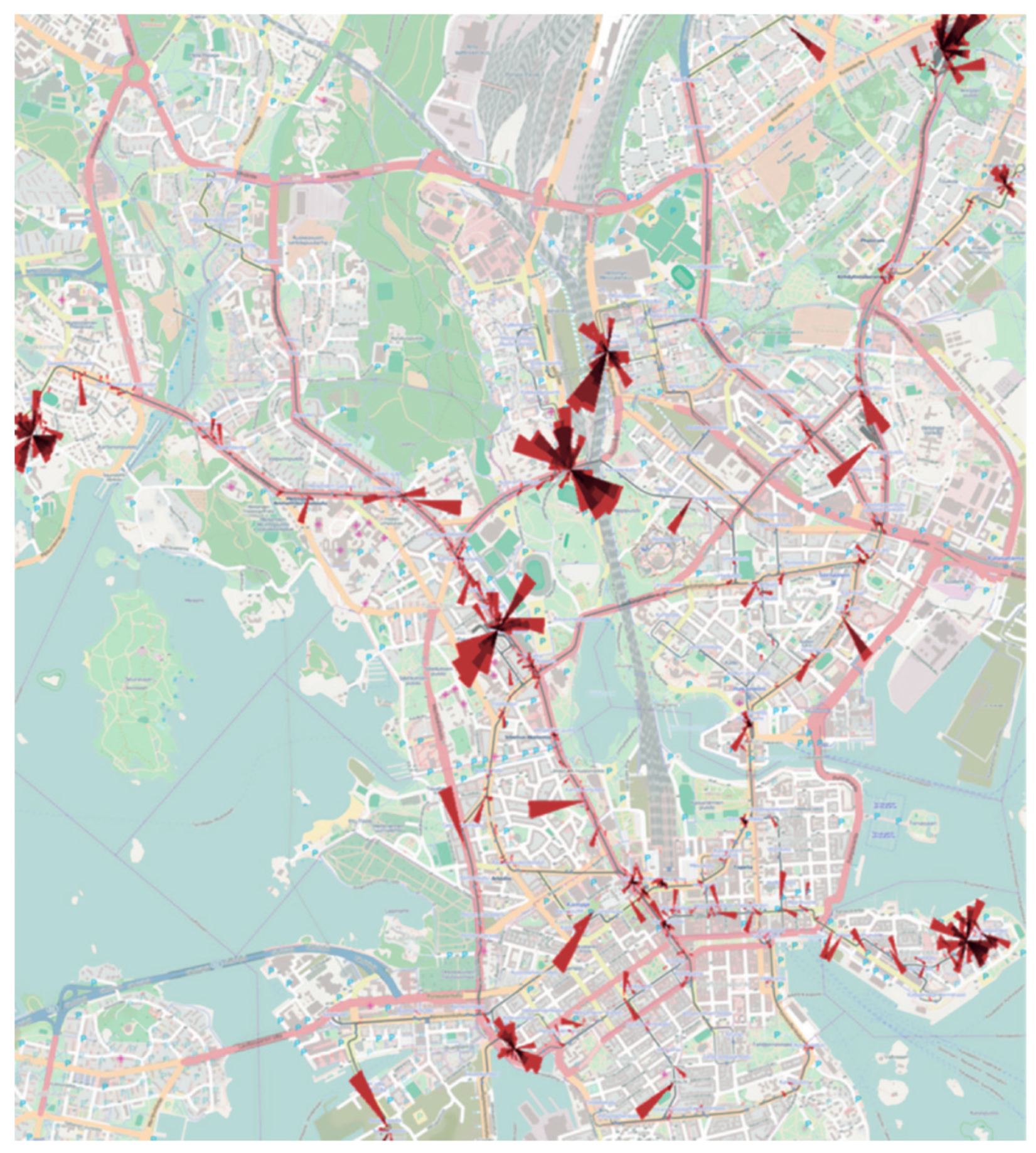
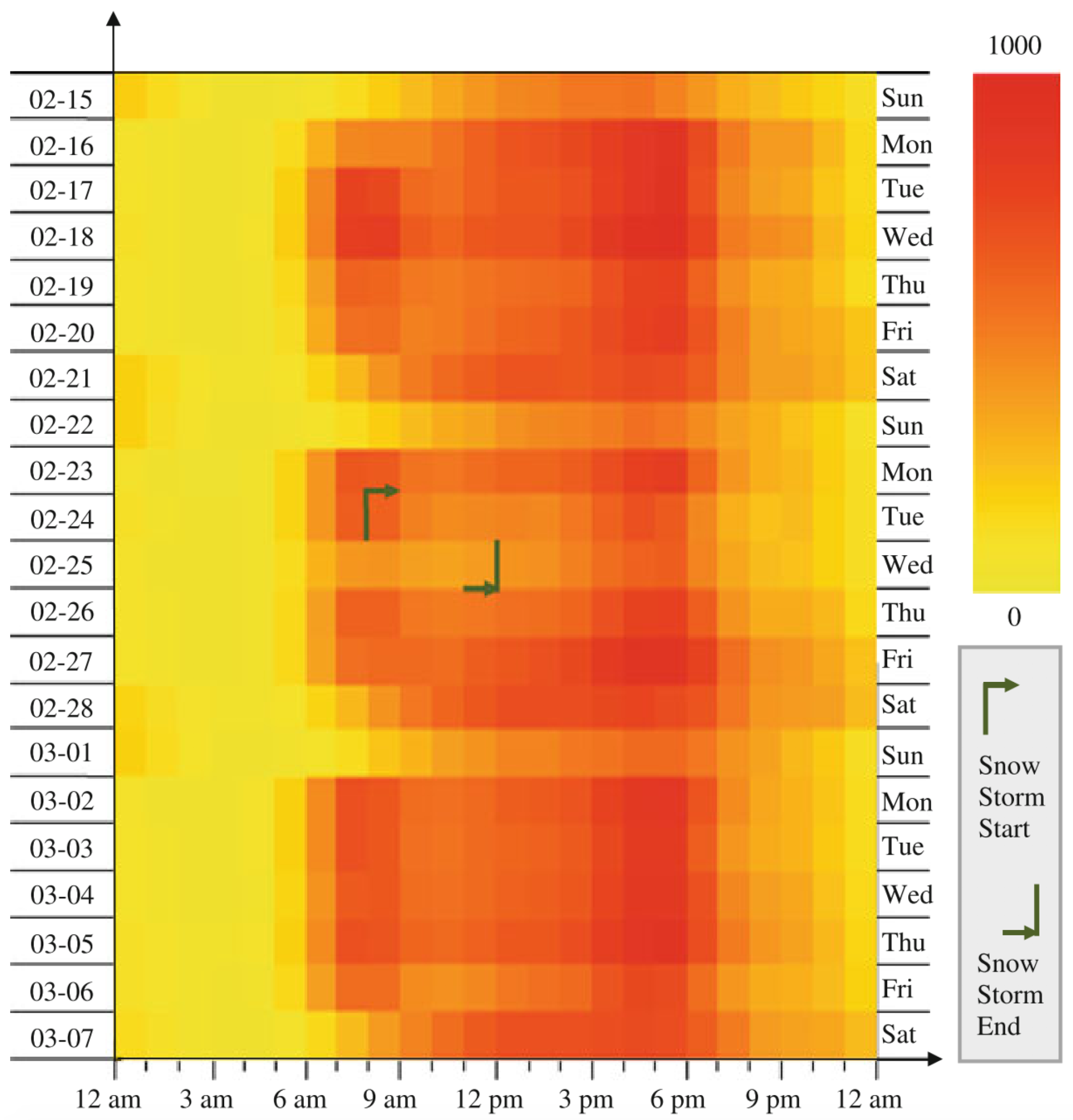
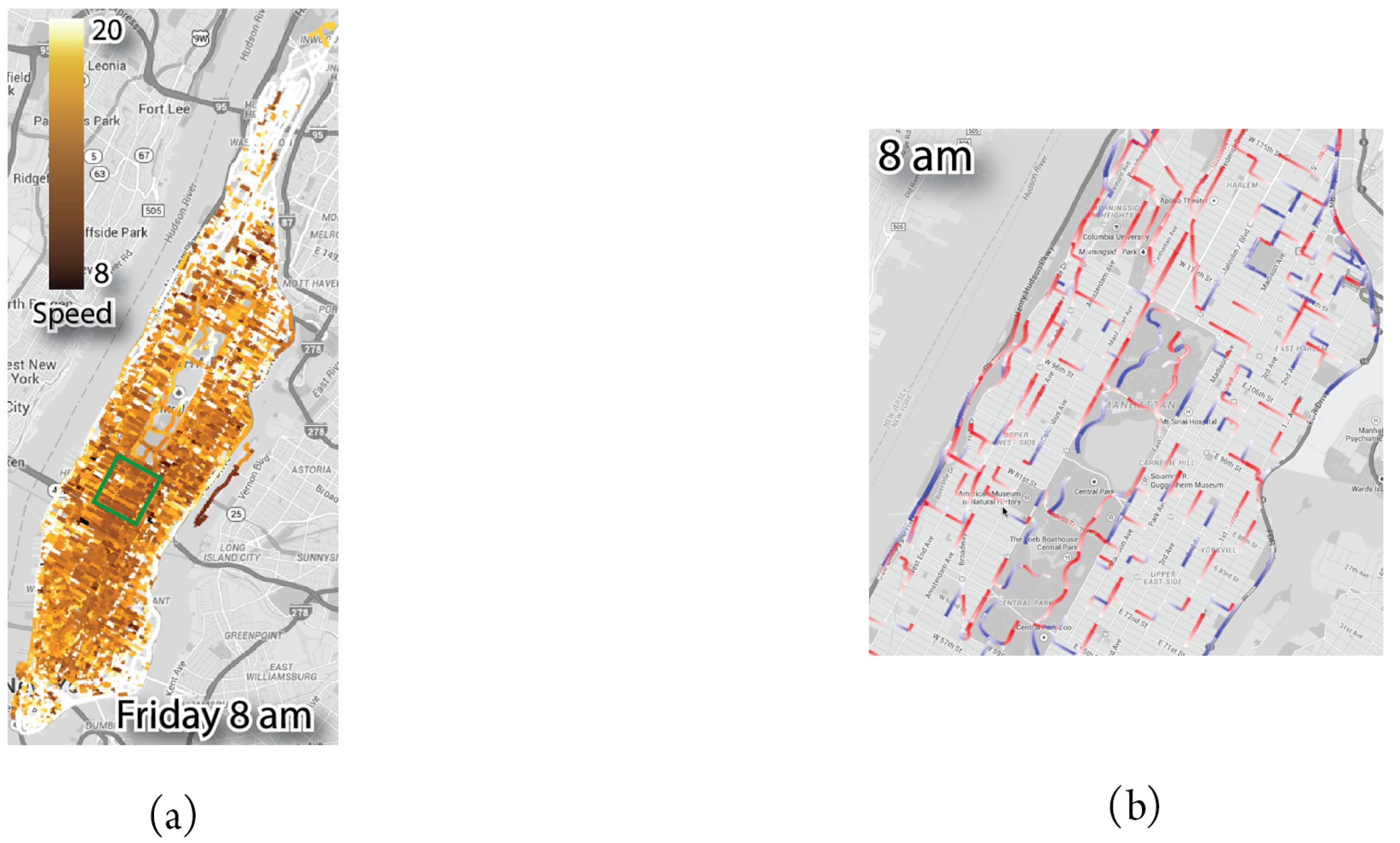
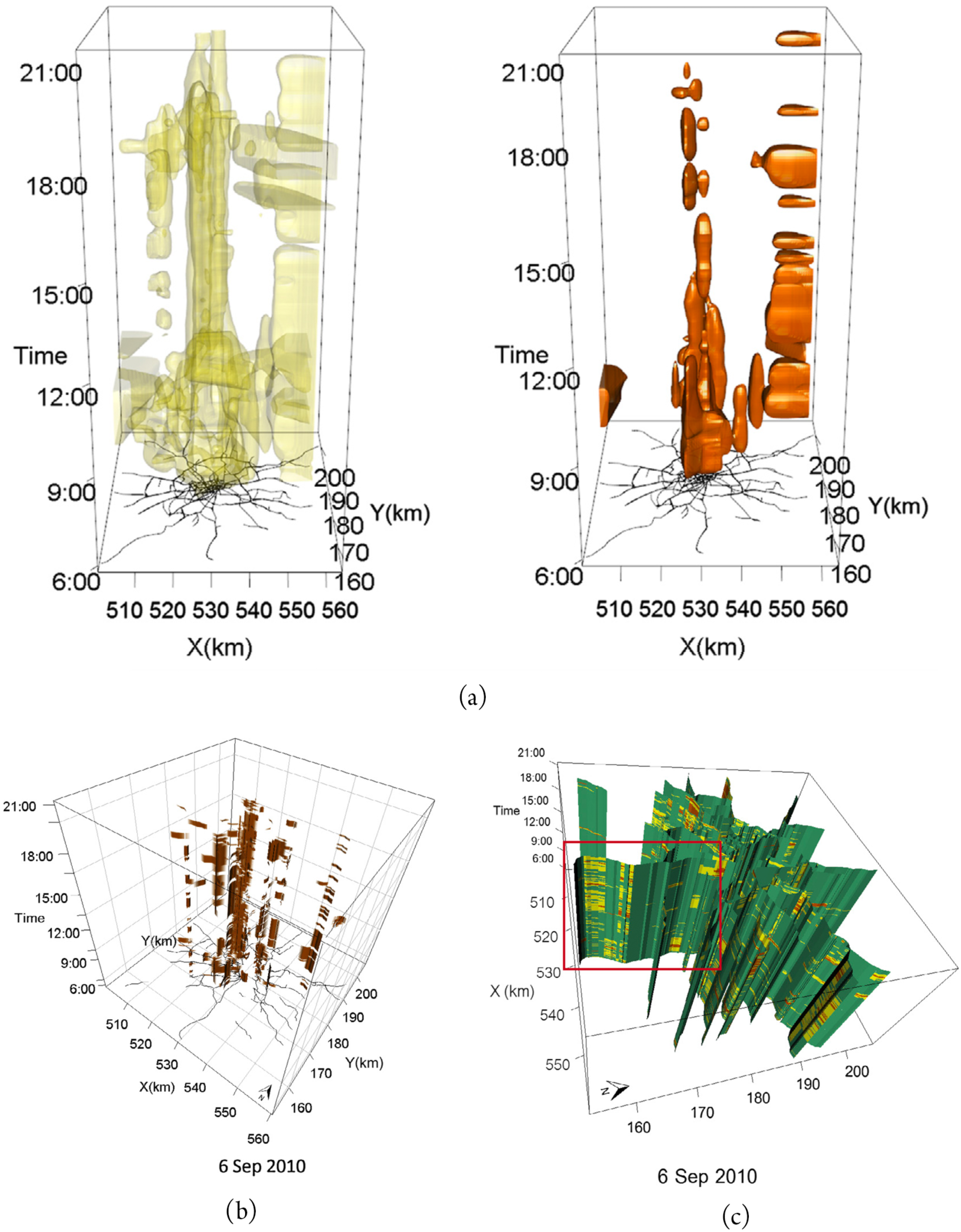
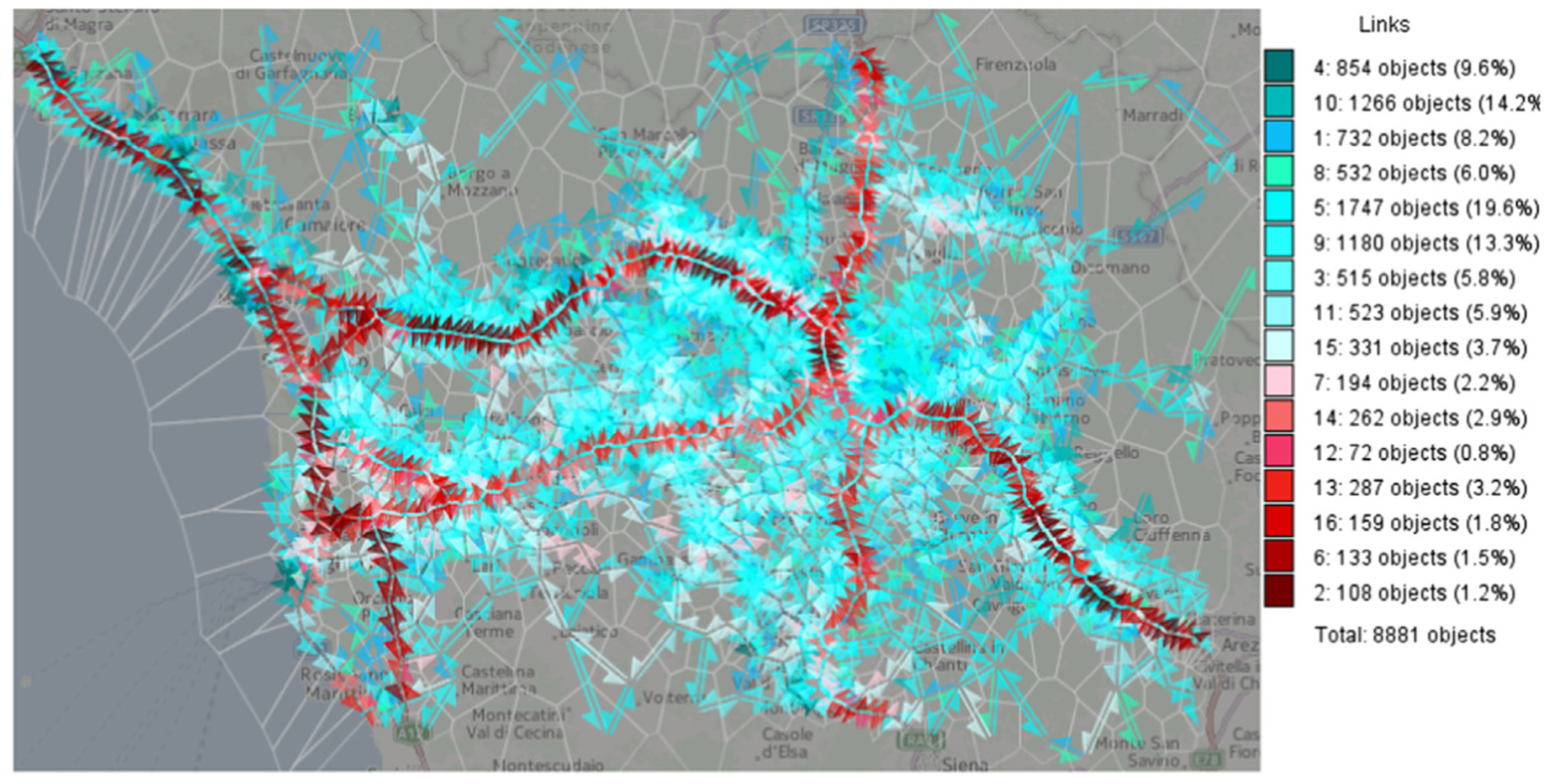
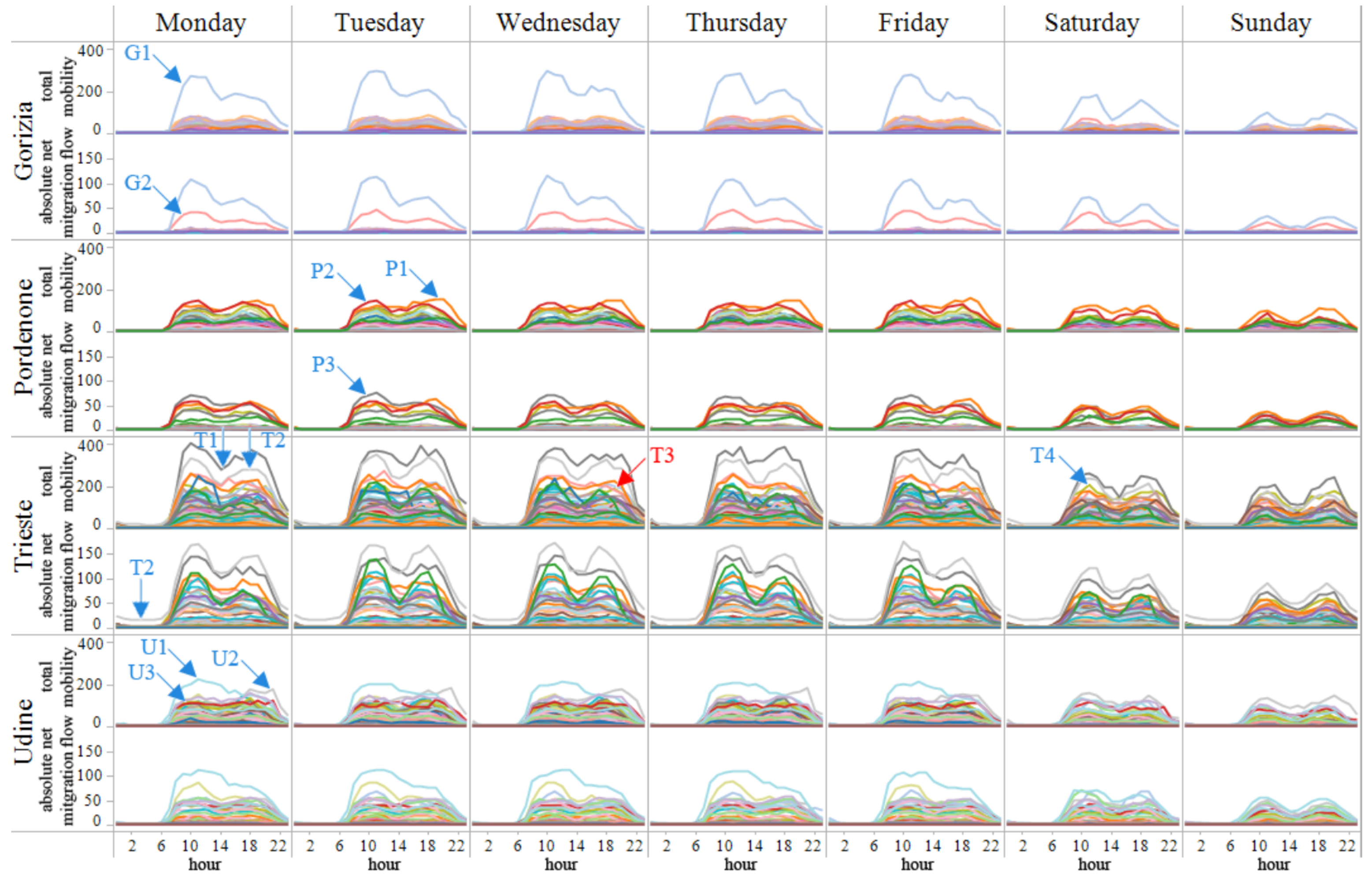
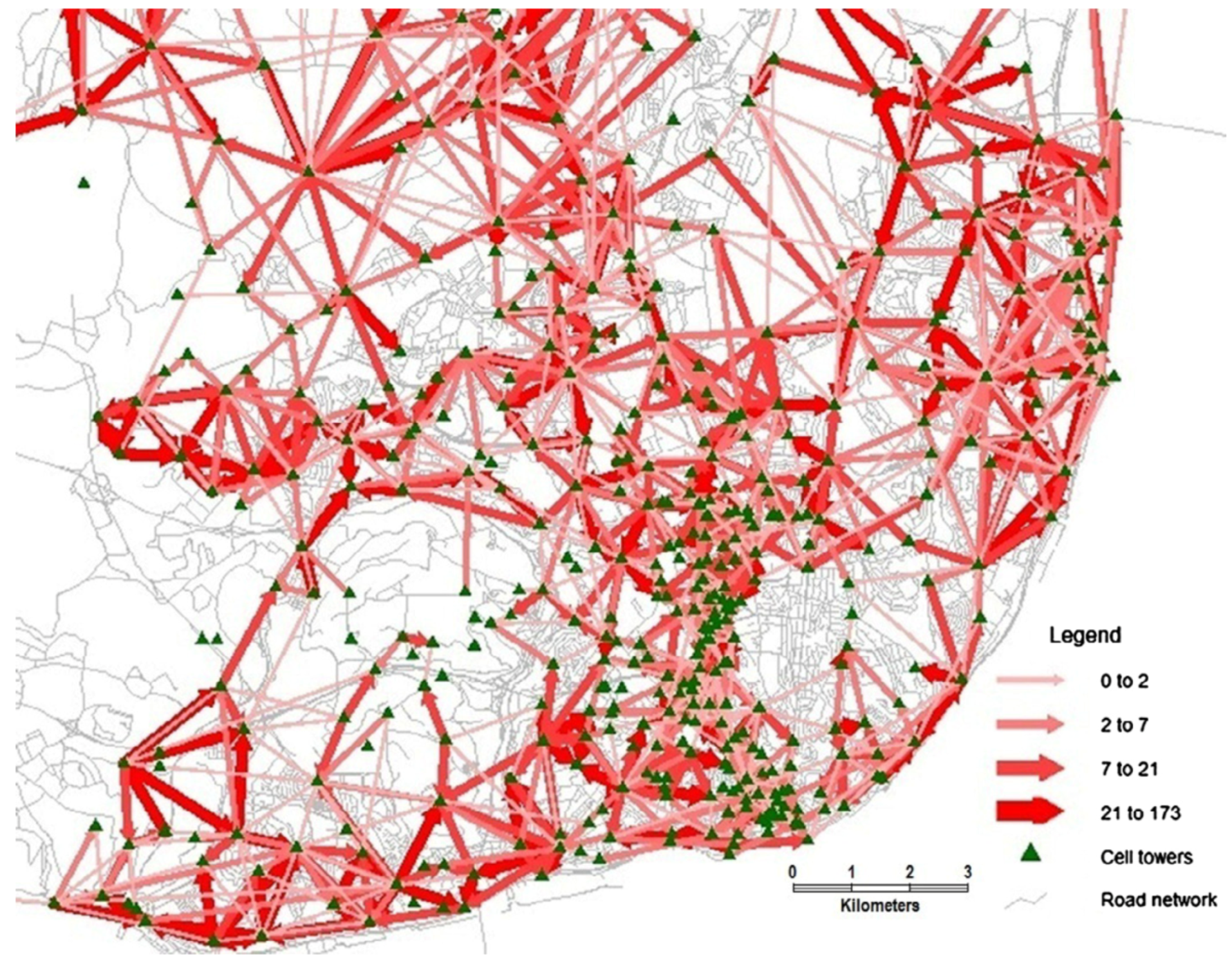
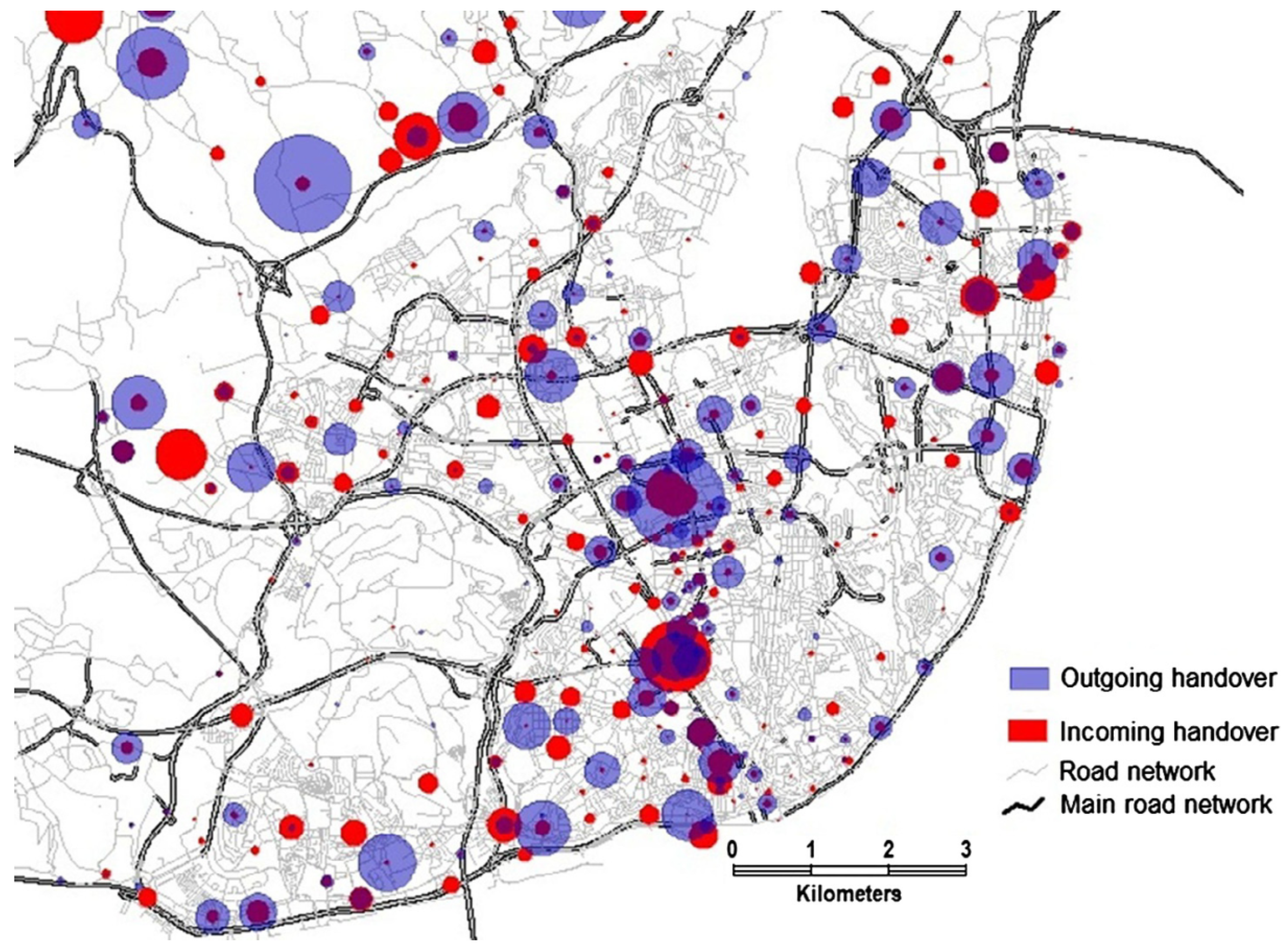
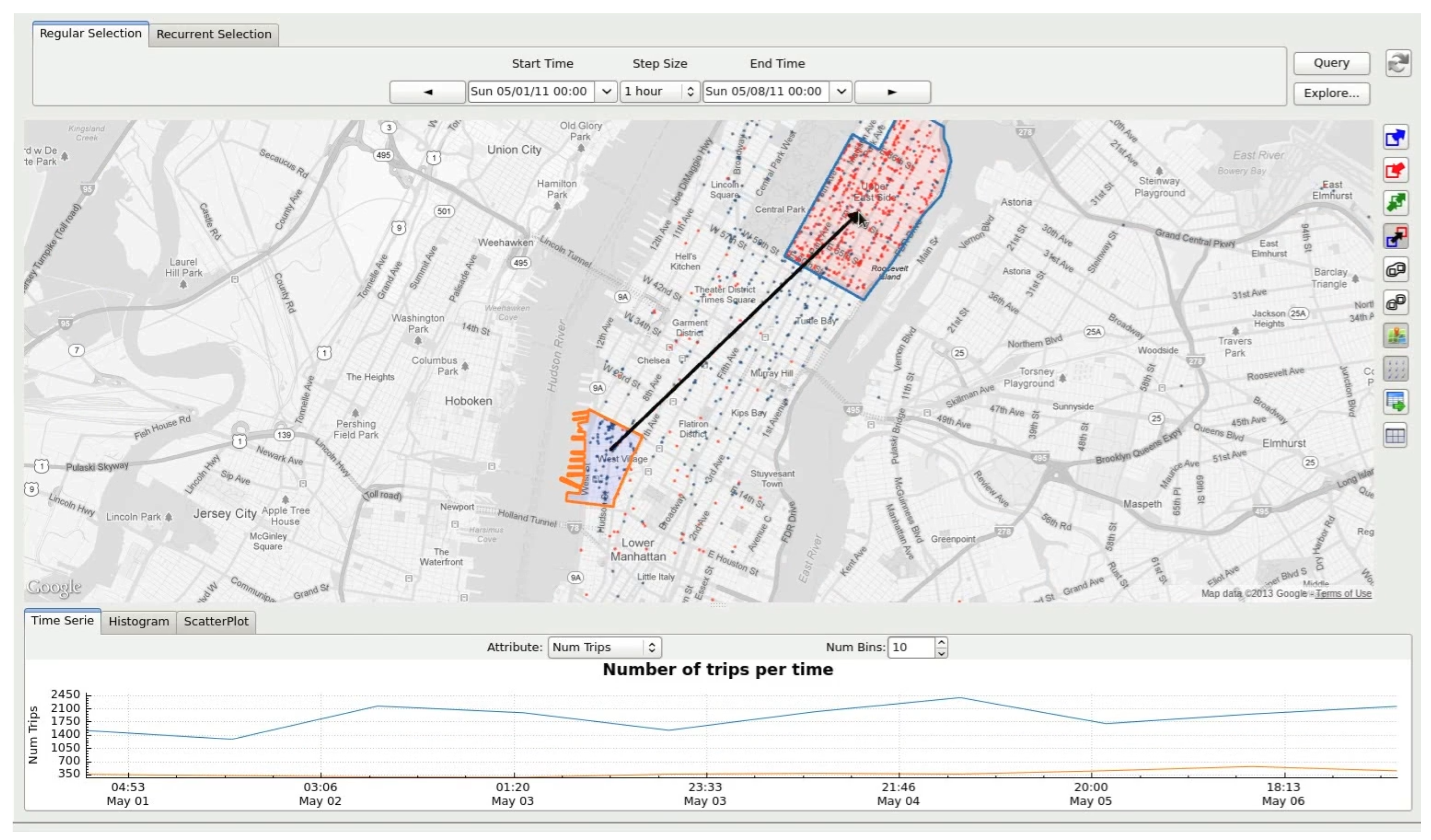
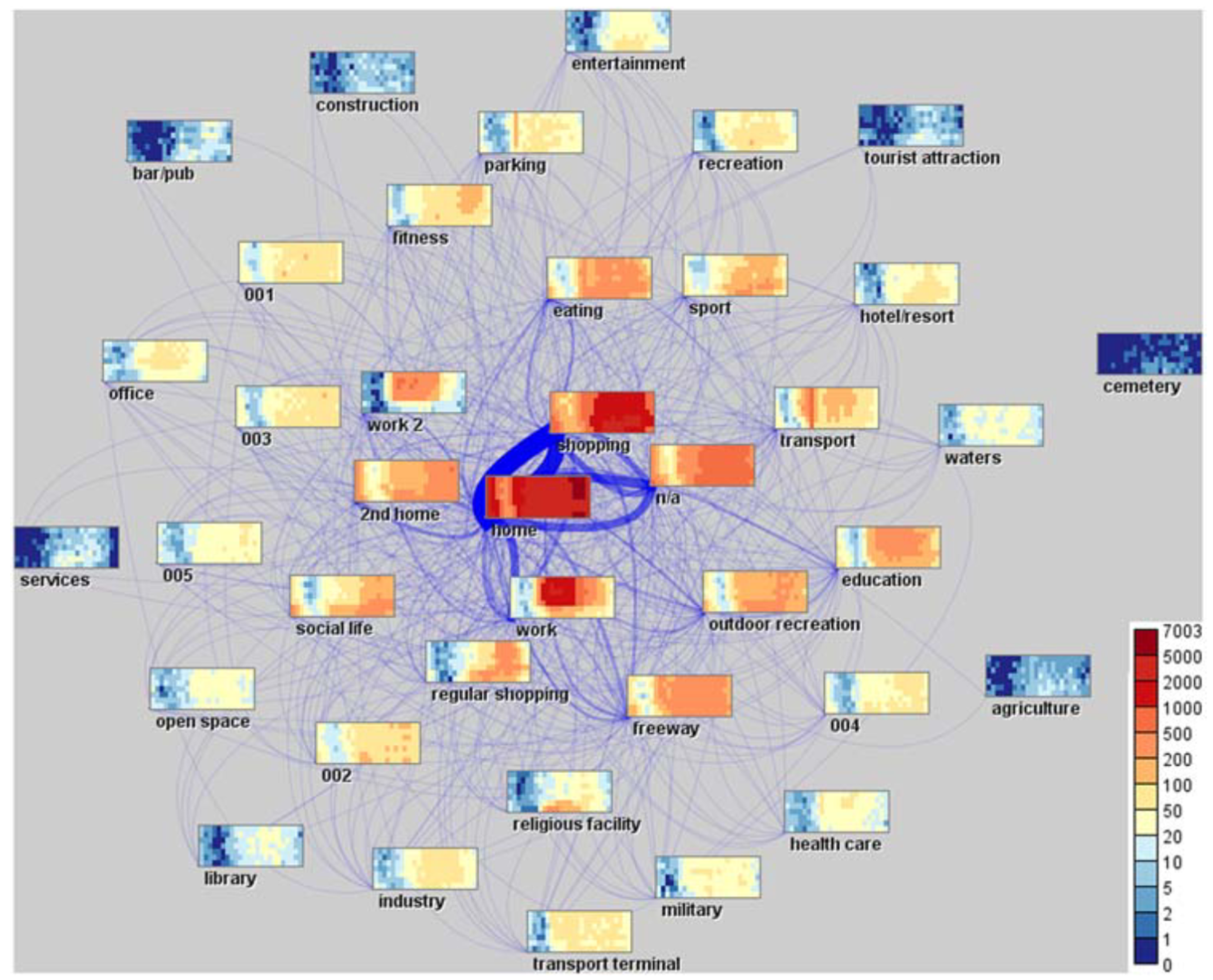
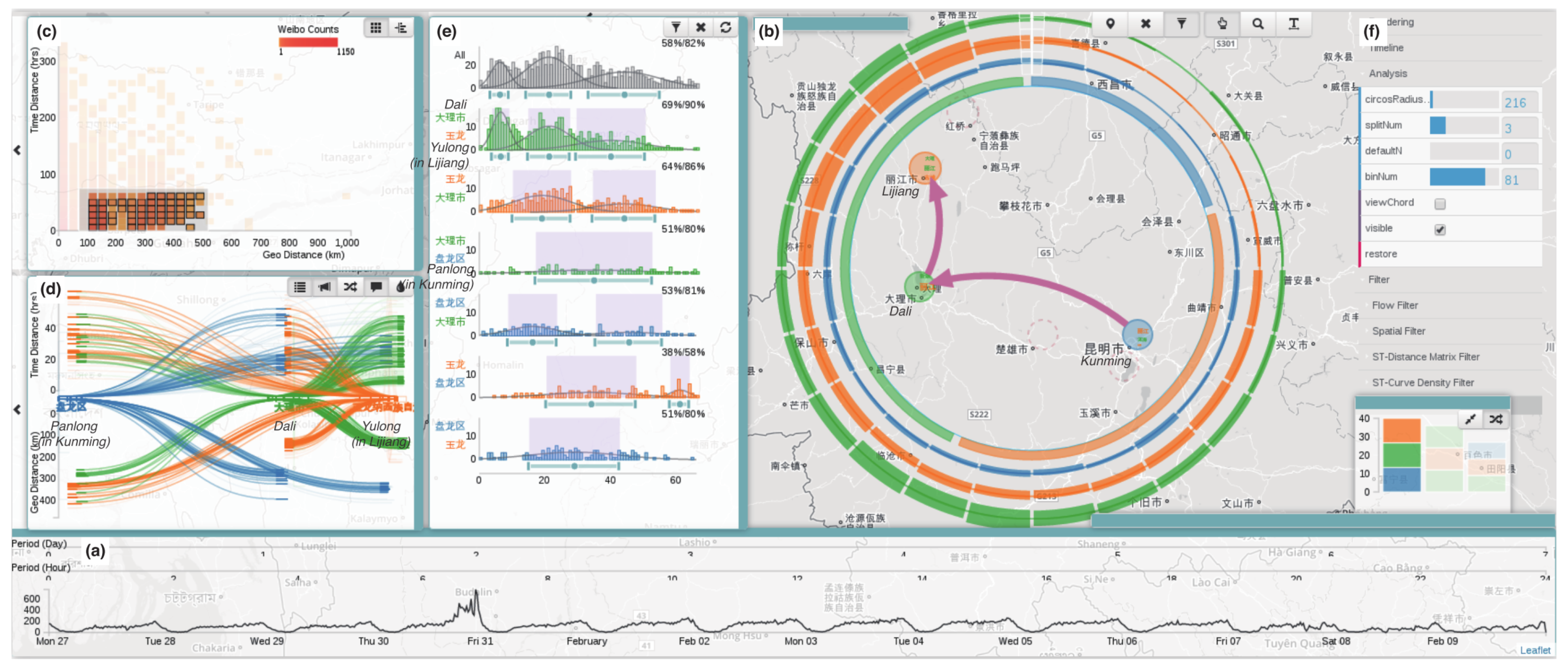
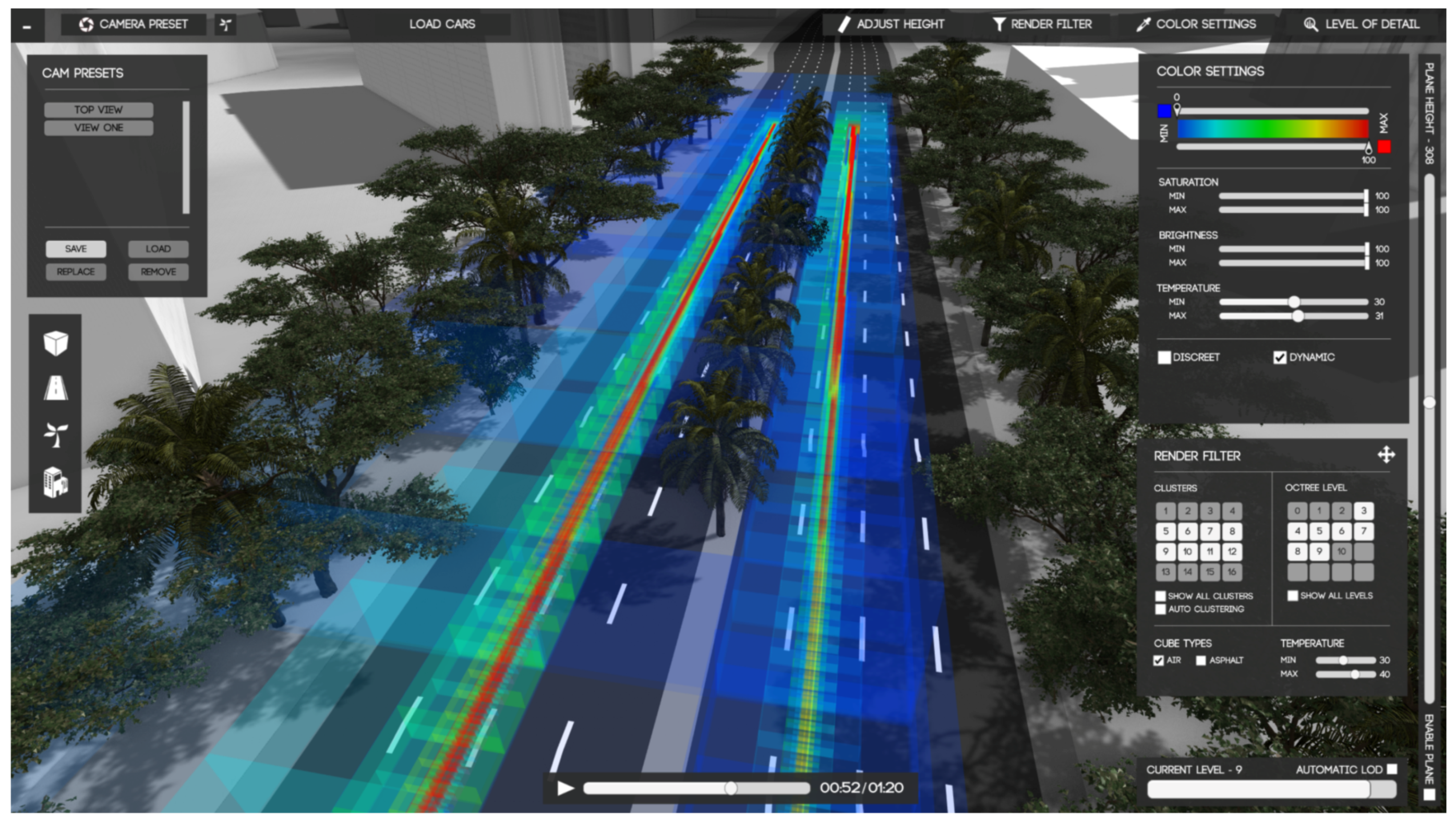
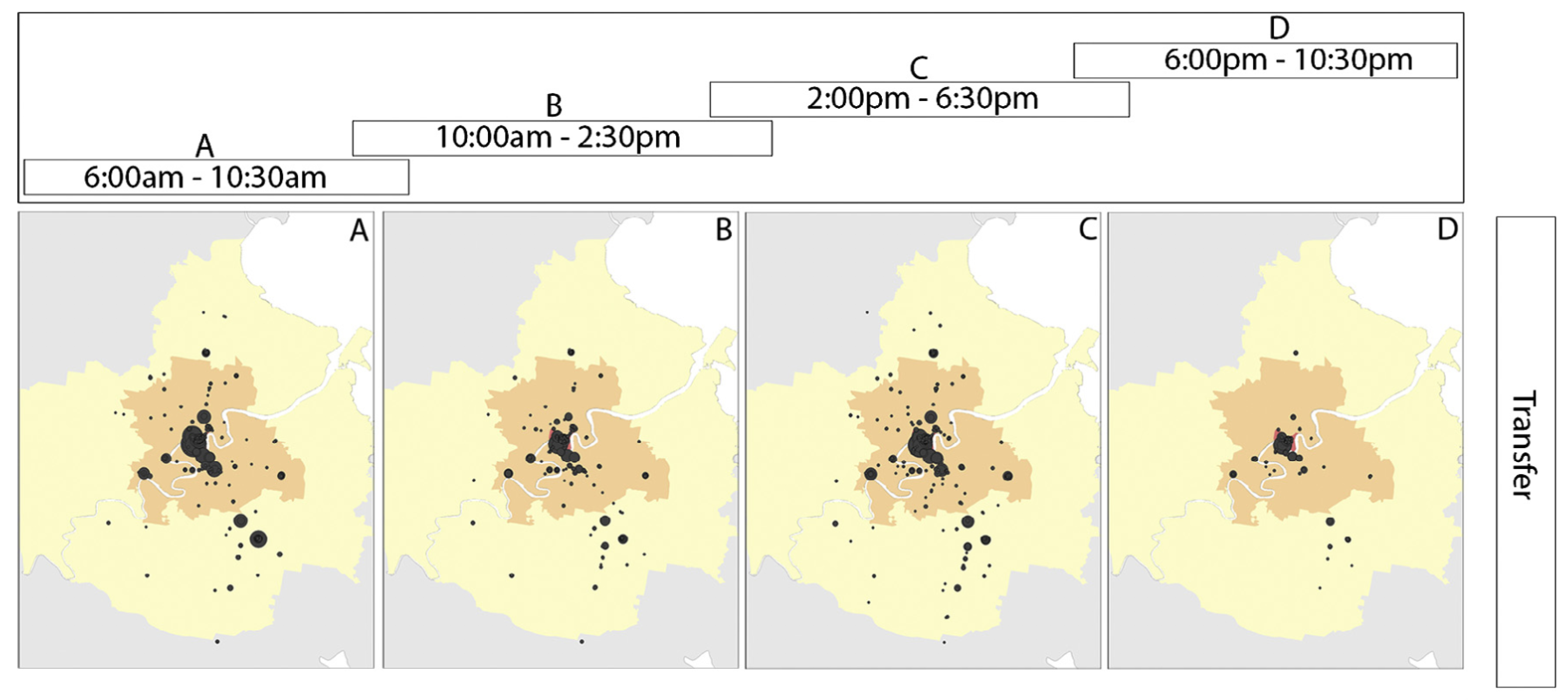
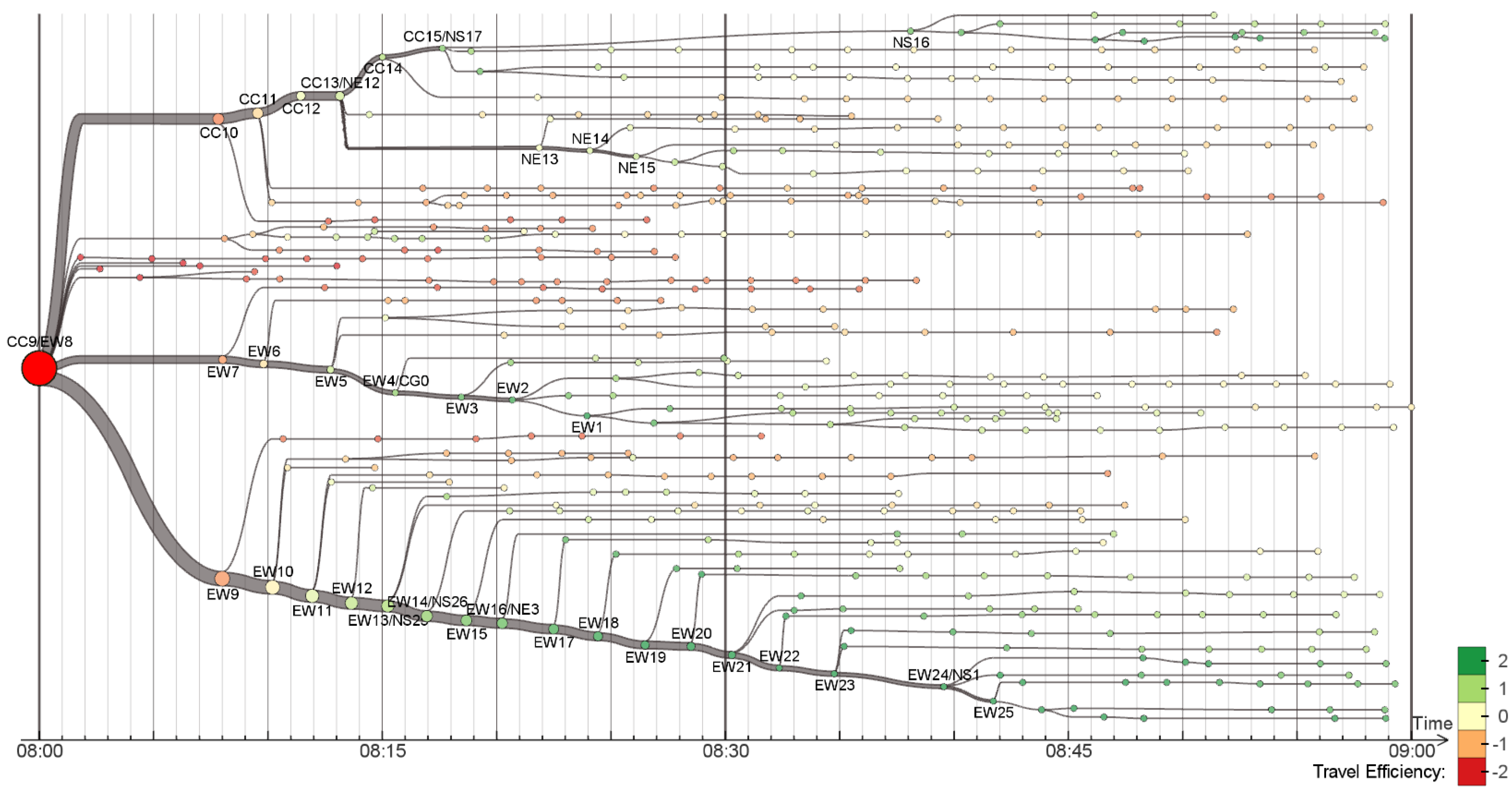
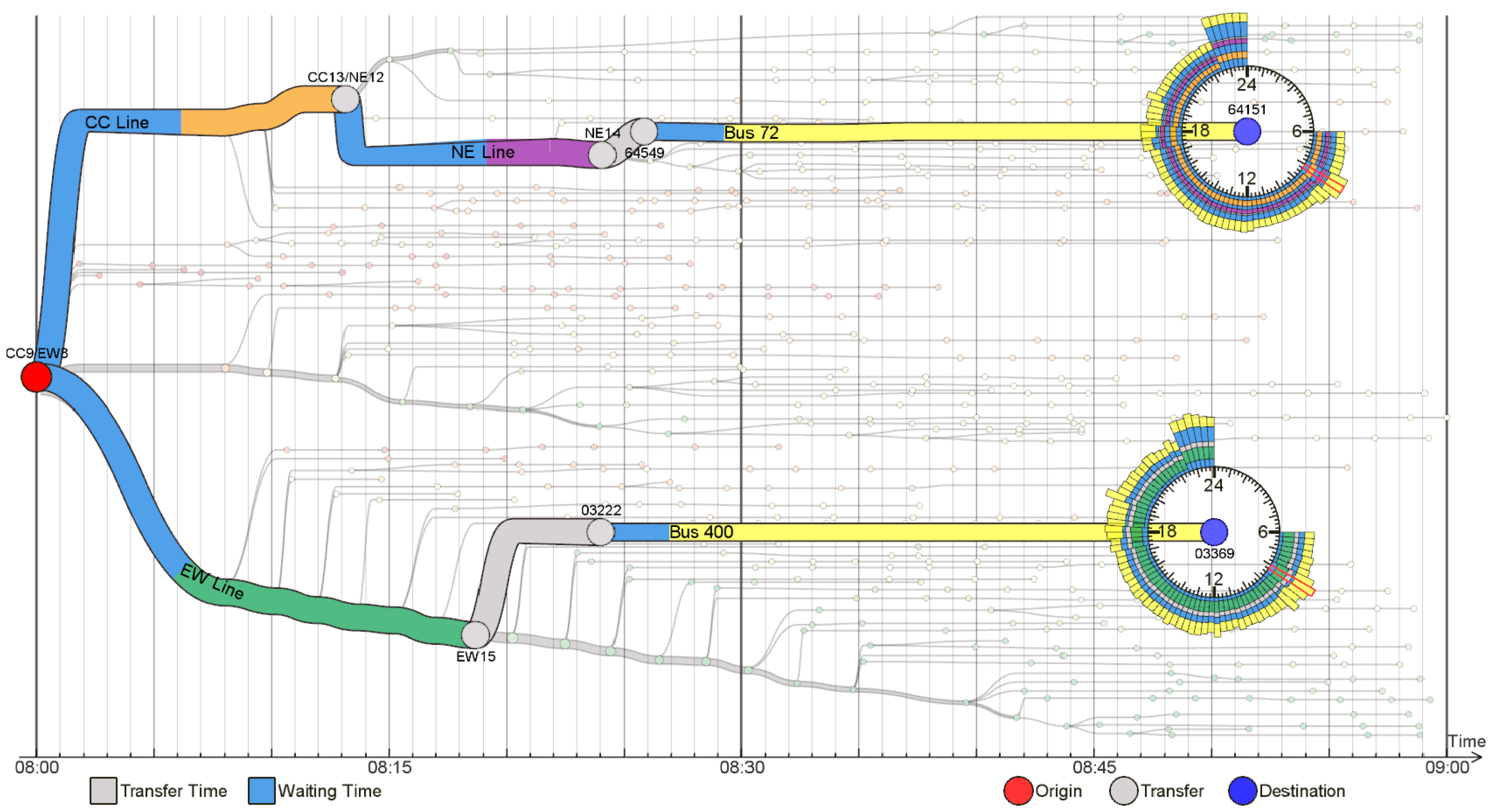
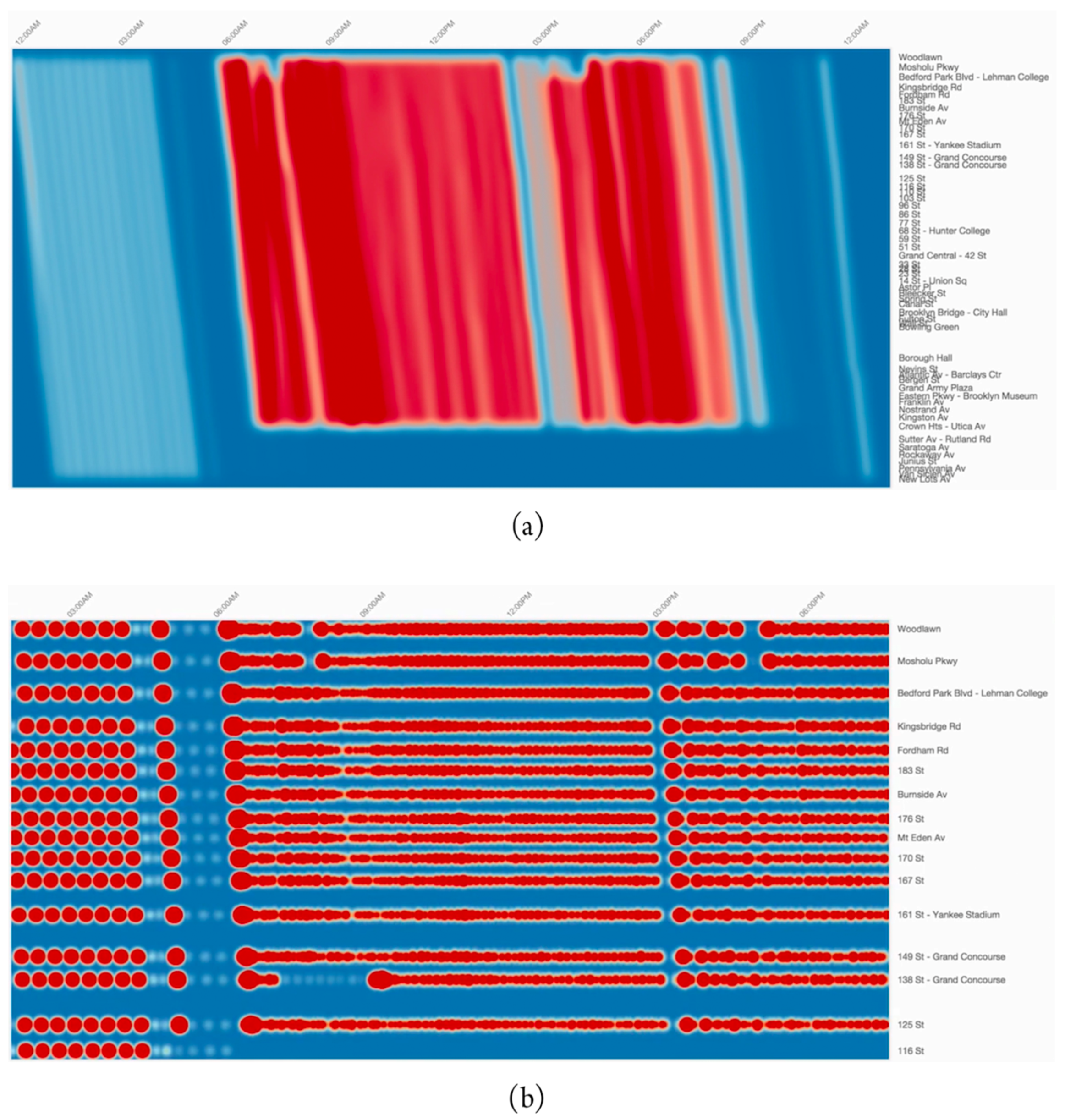
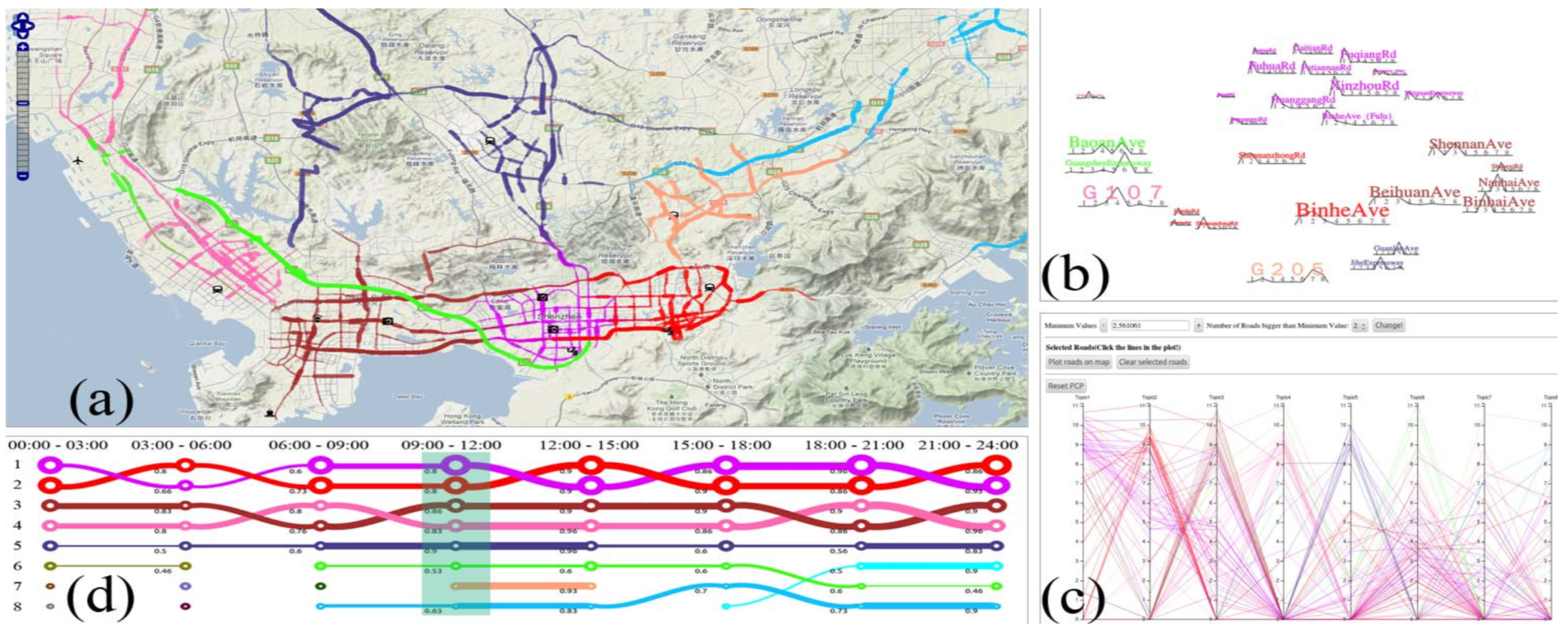

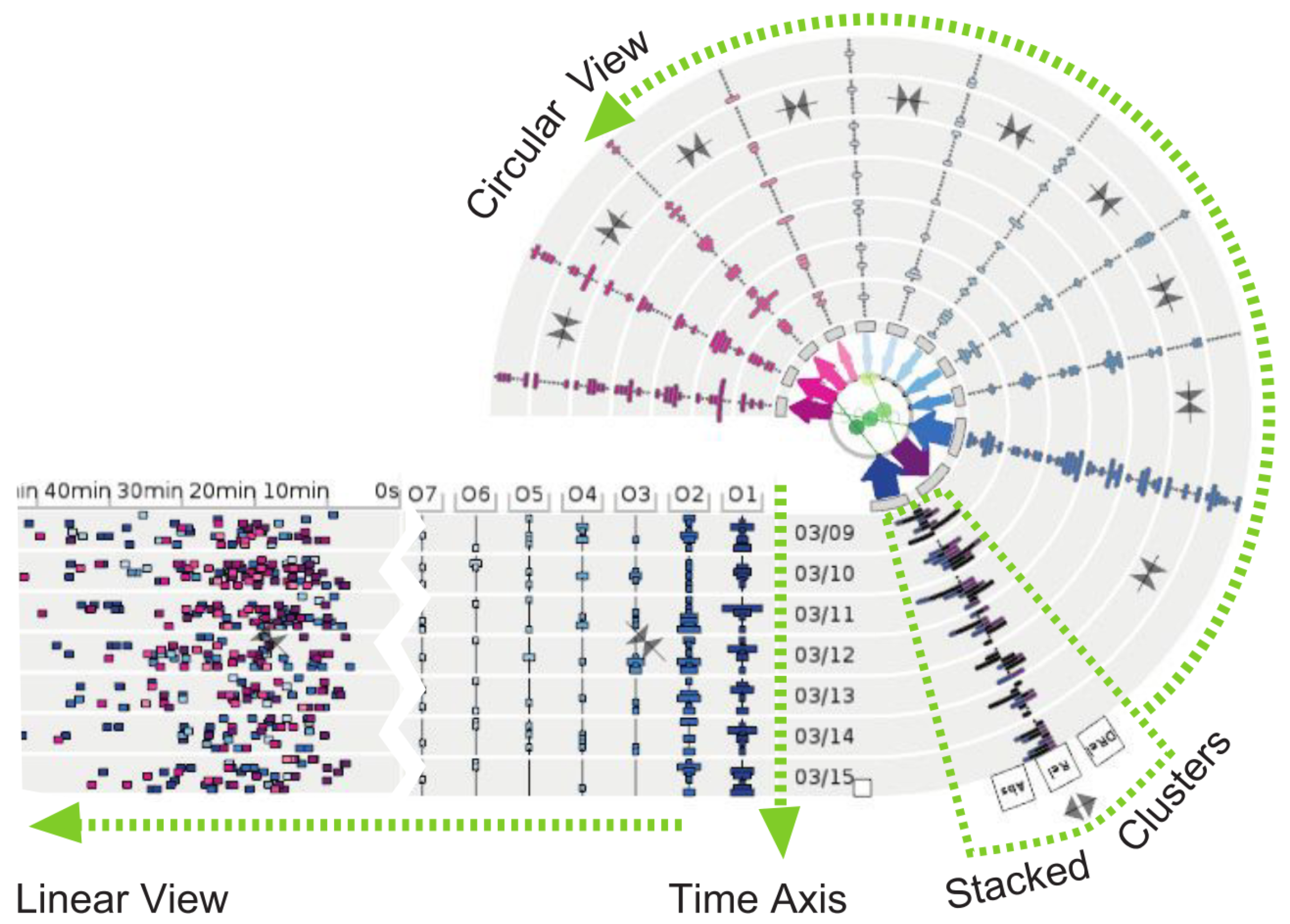
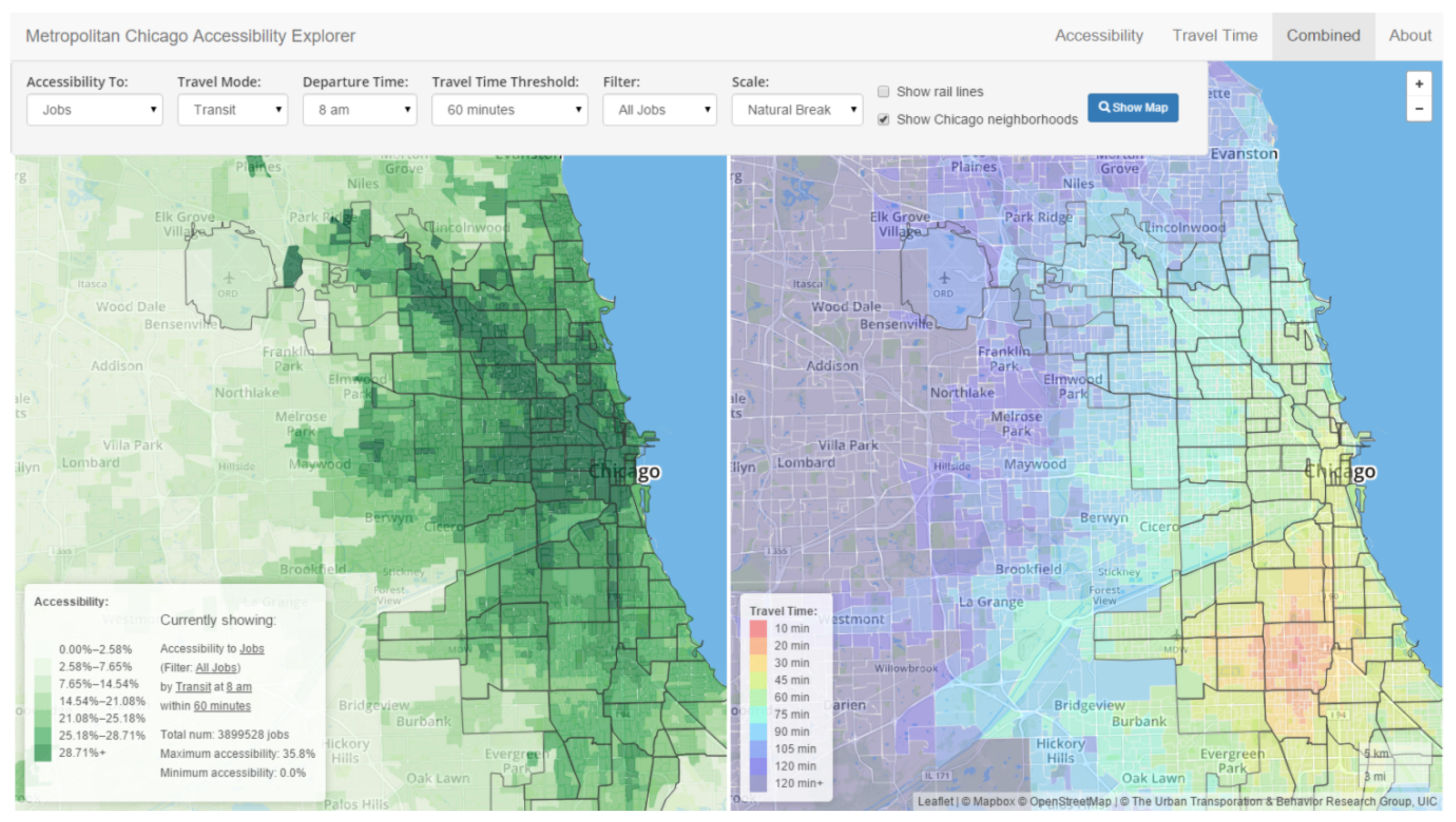
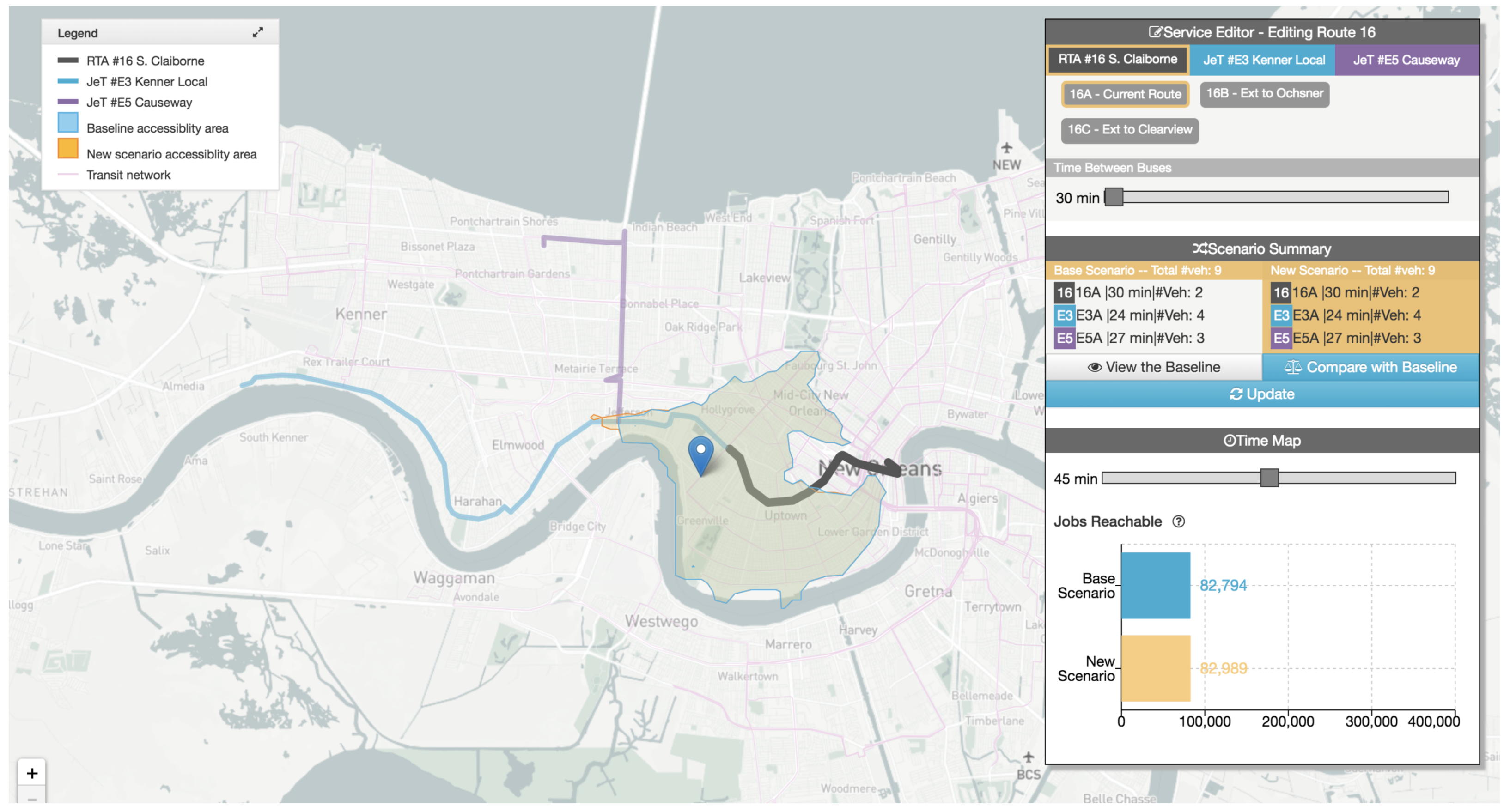

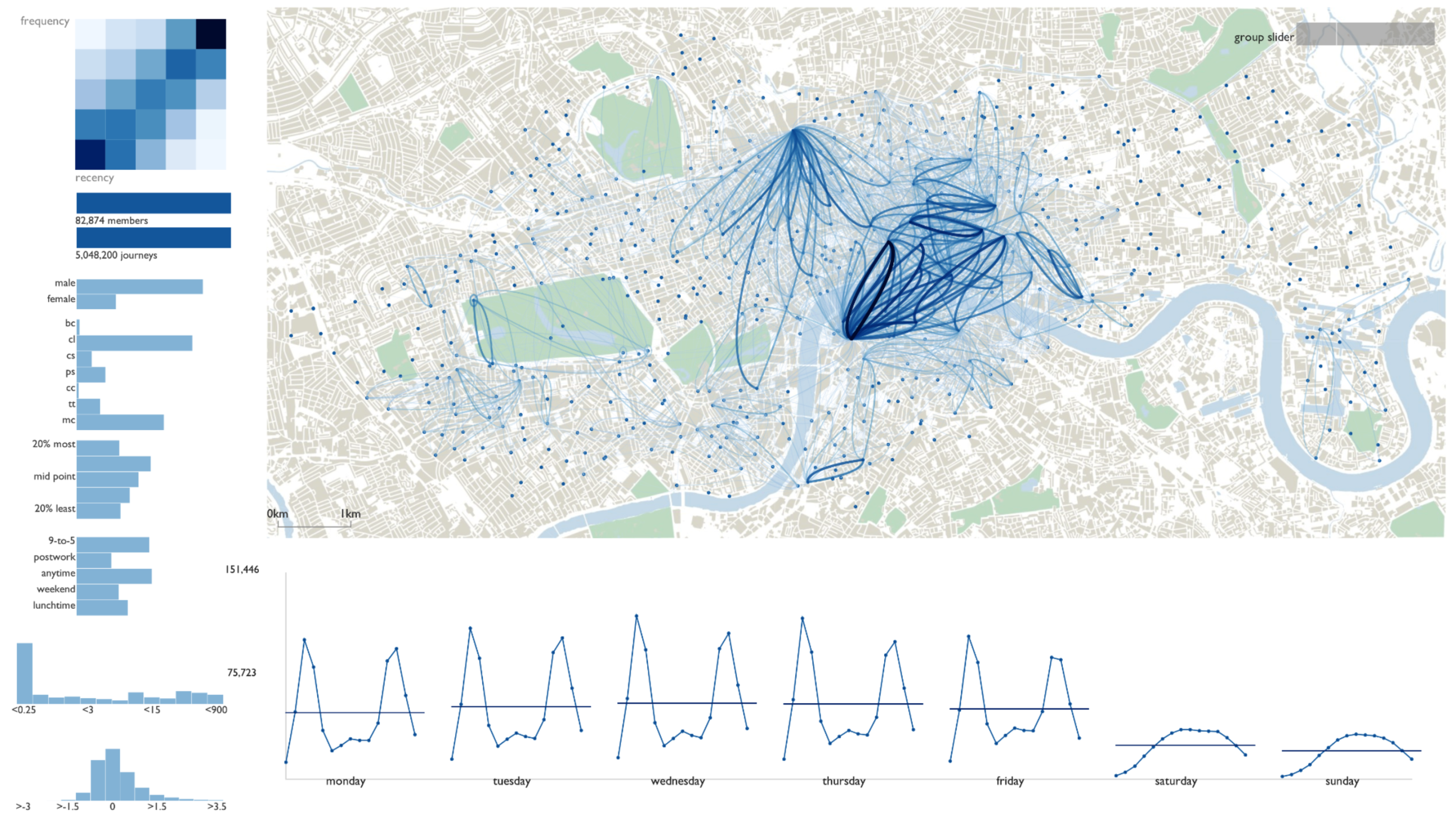
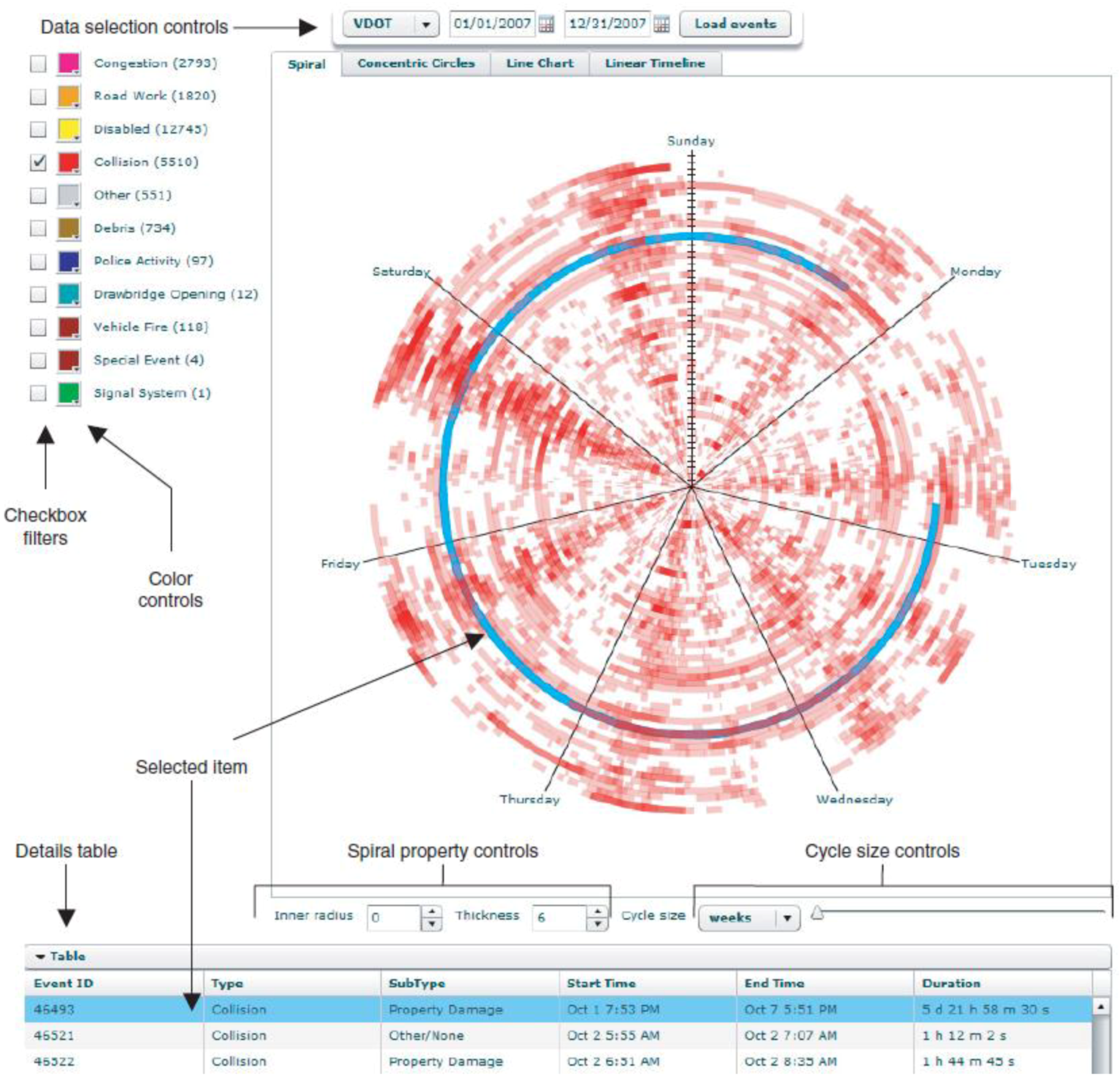

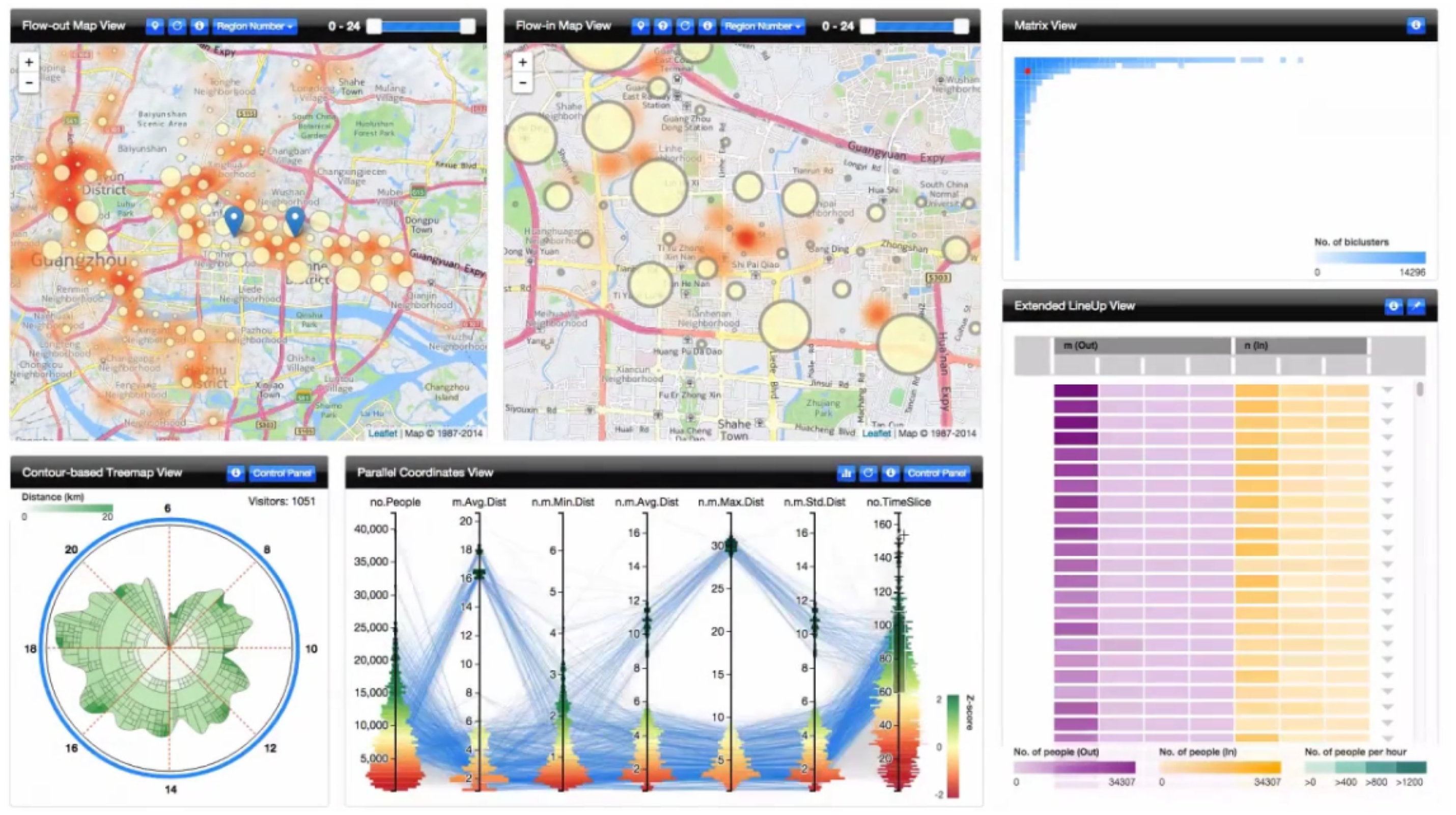
| Topics | Related Studies |
|---|---|
| Urban traffic flows and monitoring | [8,15,16,17,18,19,21,22,23,24,25,26,27,28,29,30,31,32,33,34,35,36] |
| People dynamics in urban environments | [14,36,37,38,39,40,41,42,43,44] |
| Road traffic incidents | [48,49,50,51,52] |
| Air pollution | [17,53,54,55,56] |
| Travel behavior on PTS | [58,59,60,61] |
| Level of Service on PTS | [64,65,66,67] |
| Trip patterns | [43,69,70,71] |
| Big city data | [73,74,75] |
| Travel demand | [76,77,78] |
| Public tansportation ridership | [84,85] |
| Sparse trajectory data | [14,89] |
| Cyclist behavior | [87,88] |
| Temporal transportation data | [90,93] |
| Commuting efficiency | [79] |
| Accessibility | [80,81] |
| Urban traffic conversations | [91] |
| Interchange patterns | [92] |
| Co-occurrence | [94] |
| Groups | Subgroups | Data Types | Related Studies |
|---|---|---|---|
| Sensors | Activity-based | Floating car data | [79] |
| Mobile phone data | [37,38,39,40,41,42,76,94] | ||
| Smart card data (AFC) | [58,59,60,61,75,85,92] | ||
| Device-based | Bicycle trajectories data | [87,88] | |
| Bus AVL data | [15,55,64] | ||
| Bus GPS trajectories | [55] | ||
| Vehicle sensor data | [16,18,19,24,26,30,32,36,52,53,73,74,75,90,96] | ||
| Non-APC Passenger count data | [47,84] | ||
| Taxi GPS trajectories | [22,23,27,28,33,35,43,69,70,71,75,77,78] | ||
| Subway AVL data | [67] | ||
| Tram AVL data | [15,65,66] | ||
| Vehicle GPS trajectories | [25,93] | ||
| Location-based | Video stream data (incl. ANPR) | [31,34,56,73,89] | |
| Others | Survey-based | Household survey data | [74] |
| Land use data | [80,81] | ||
| Socio–economic data | [37,76] | ||
| Travel diary survey data | [44,47,76,97] | ||
| Report-based | Car incident record data | [48,49,50,51,52,90] | |
| Transit data | [64] | ||
| Schedule data | [55,67,80,81] | ||
| Social networks | Microblogging data | [14,32,42,91] | |
| Model-based | Highway traffic flow data | [21] | |
| Origin-destination matrices (travel demand) | [44,79] | ||
| Urban traffic flow data (network capacity, travel times) | [8,17,29,36,98] | ||
| Road traffic air pollution (emission and dispersion) or heat | [17,53,54] |
© 2019 by the authors. Licensee MDPI, Basel, Switzerland. This article is an open access article distributed under the terms and conditions of the Creative Commons Attribution (CC BY) license (http://creativecommons.org/licenses/by/4.0/).
Share and Cite
Sobral, T.; Galvão, T.; Borges, J. Visualization of Urban Mobility Data from Intelligent Transportation Systems. Sensors 2019, 19, 332. https://doi.org/10.3390/s19020332
Sobral T, Galvão T, Borges J. Visualization of Urban Mobility Data from Intelligent Transportation Systems. Sensors. 2019; 19(2):332. https://doi.org/10.3390/s19020332
Chicago/Turabian StyleSobral, Thiago, Teresa Galvão, and José Borges. 2019. "Visualization of Urban Mobility Data from Intelligent Transportation Systems" Sensors 19, no. 2: 332. https://doi.org/10.3390/s19020332
APA StyleSobral, T., Galvão, T., & Borges, J. (2019). Visualization of Urban Mobility Data from Intelligent Transportation Systems. Sensors, 19(2), 332. https://doi.org/10.3390/s19020332






